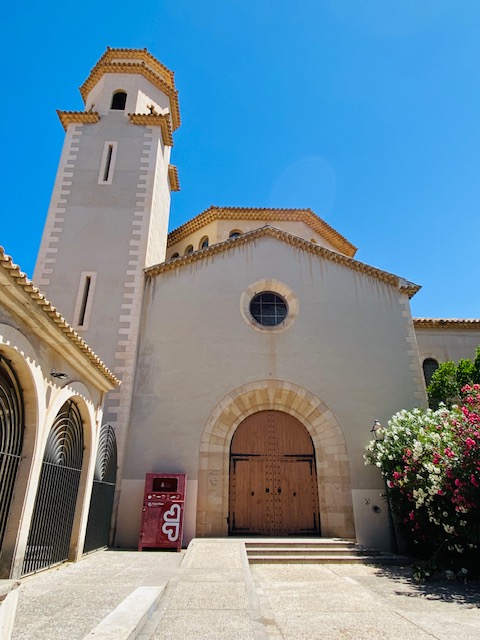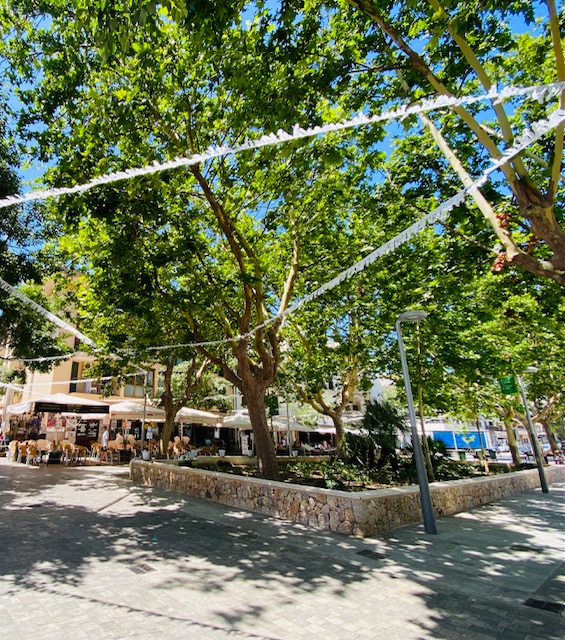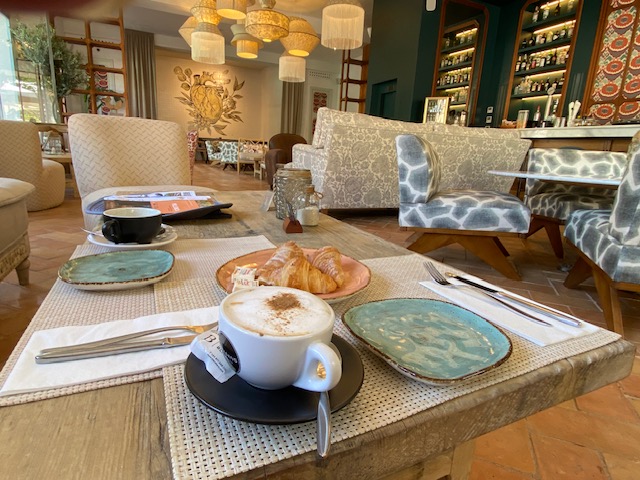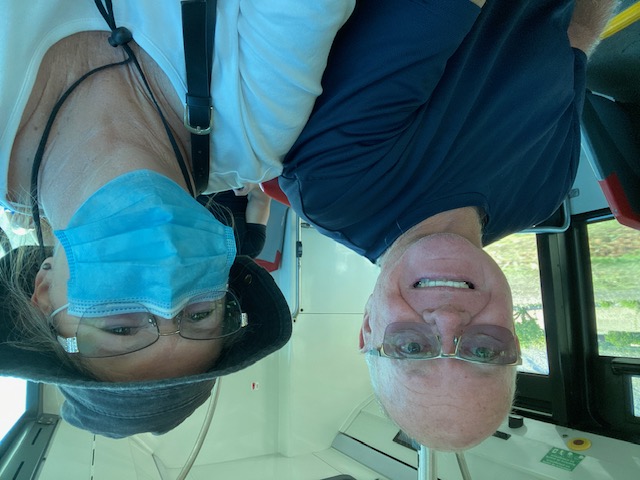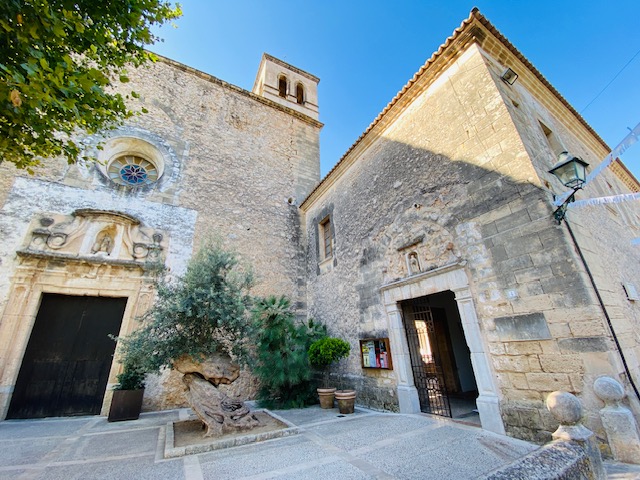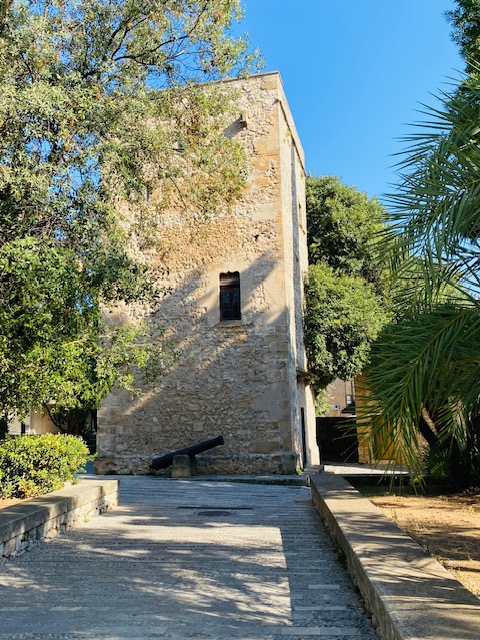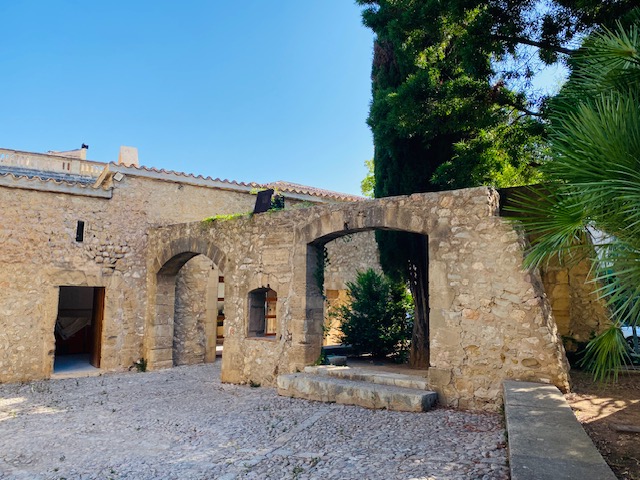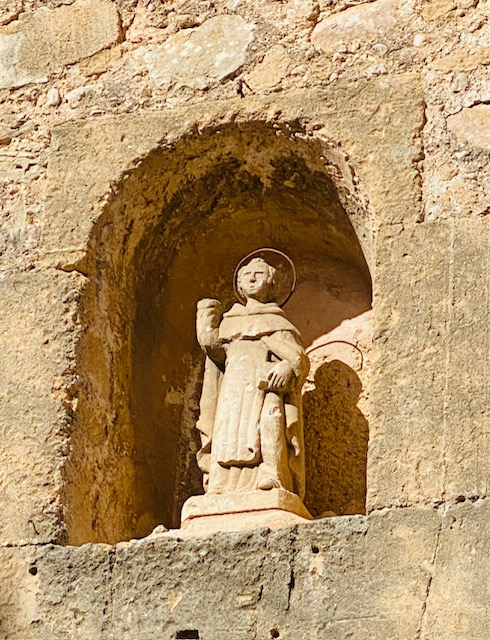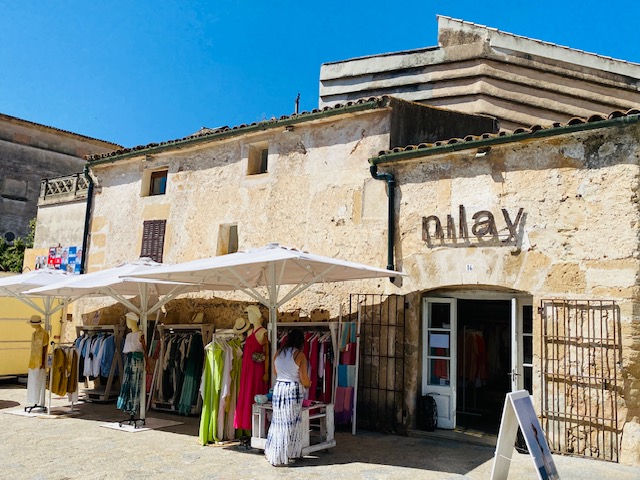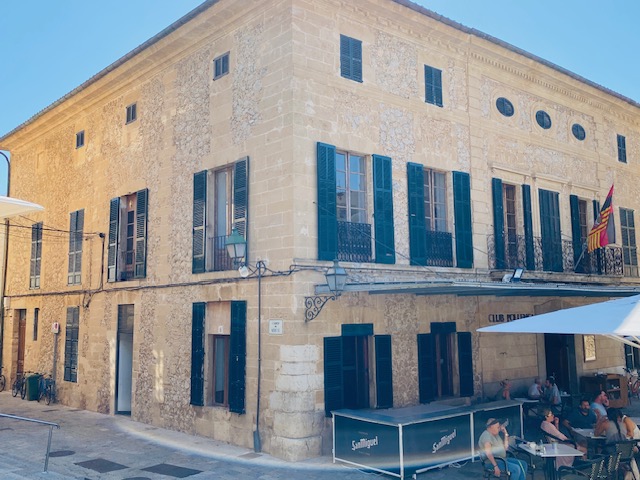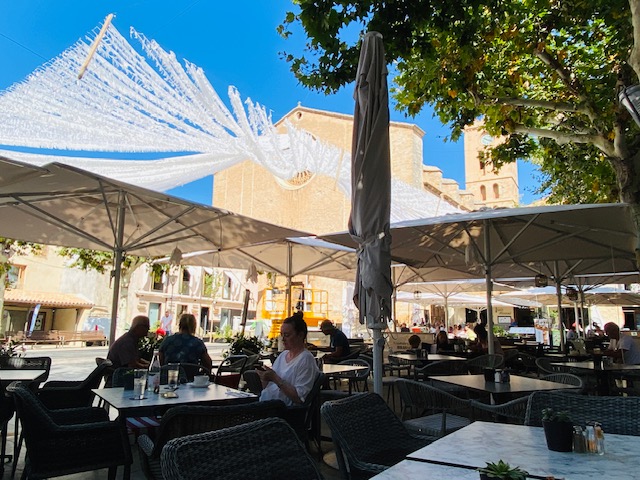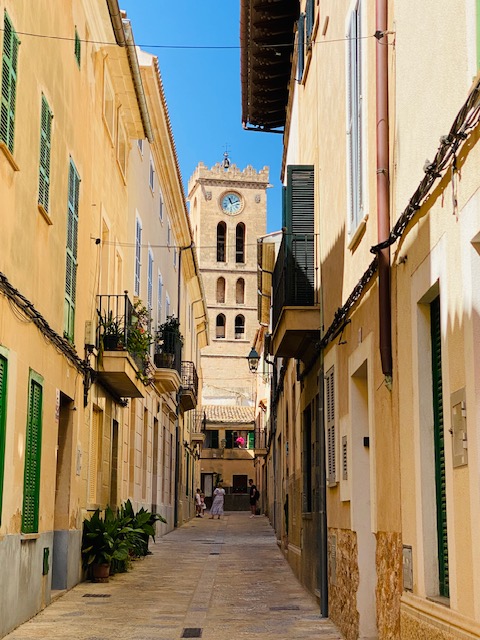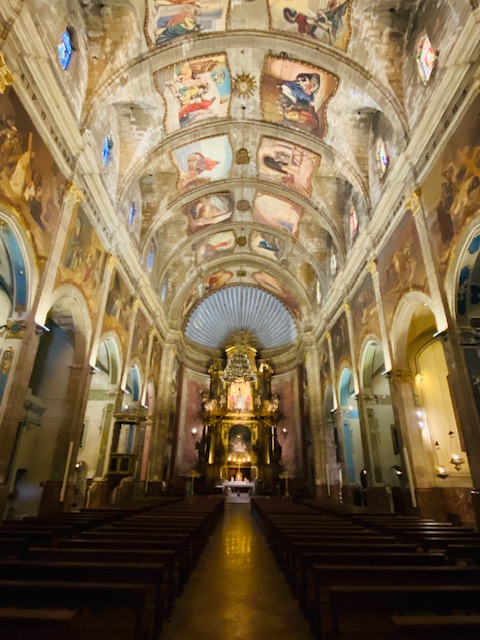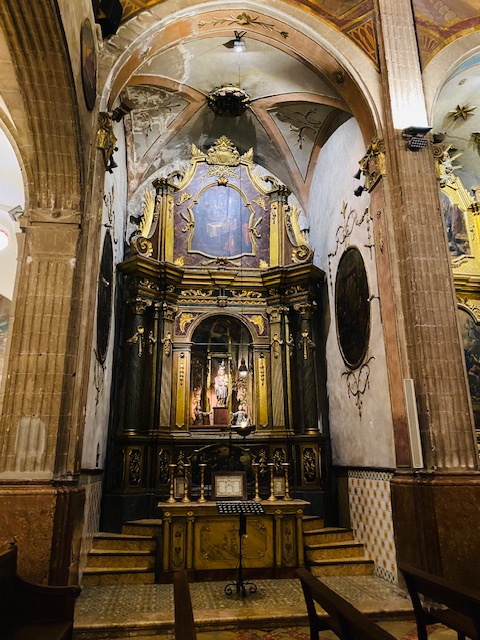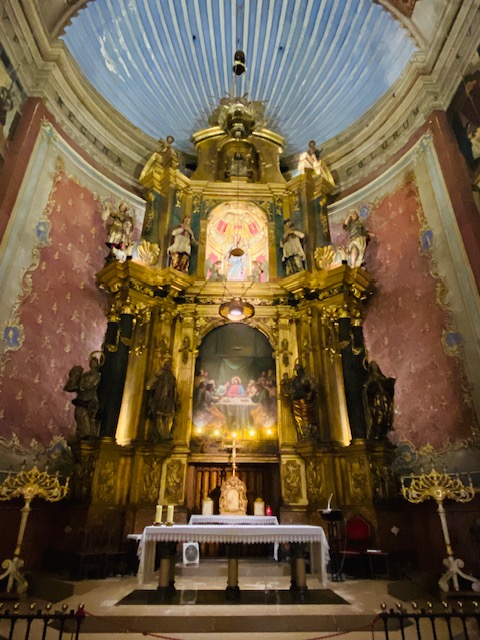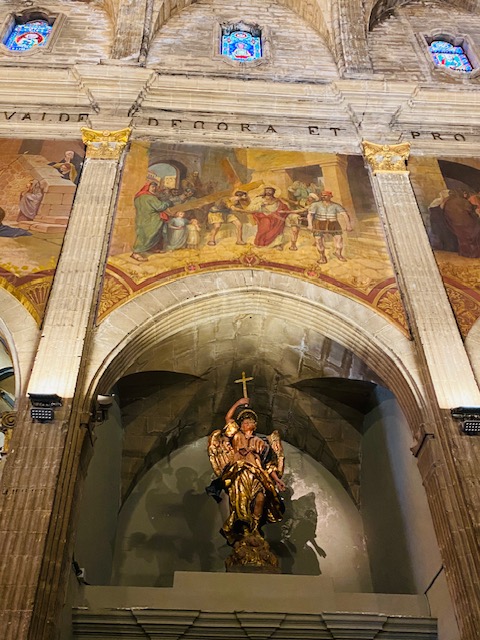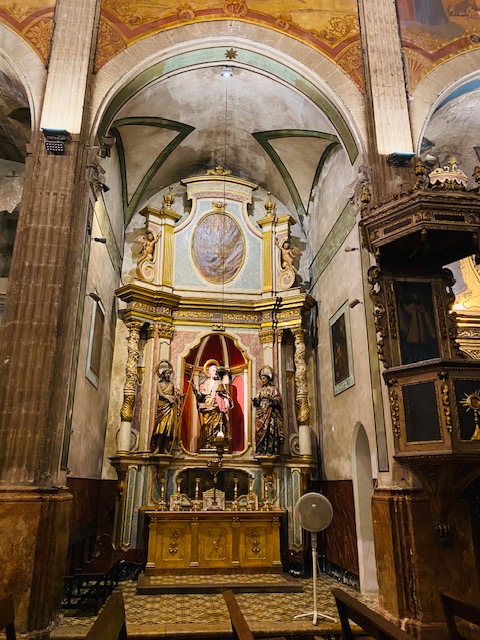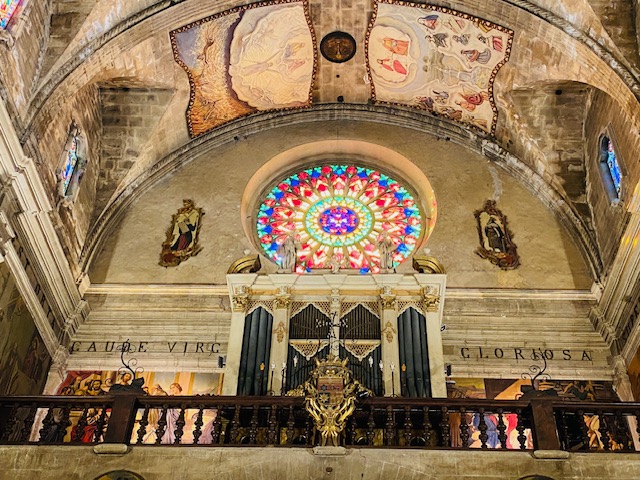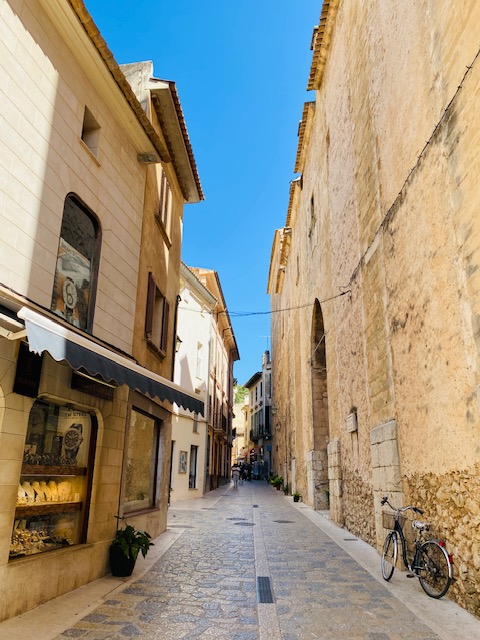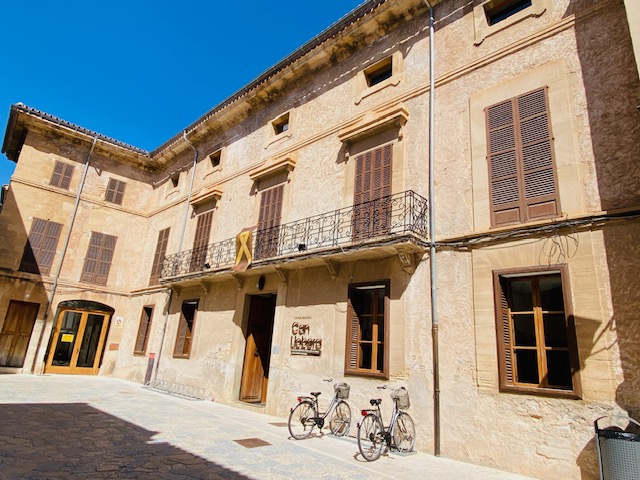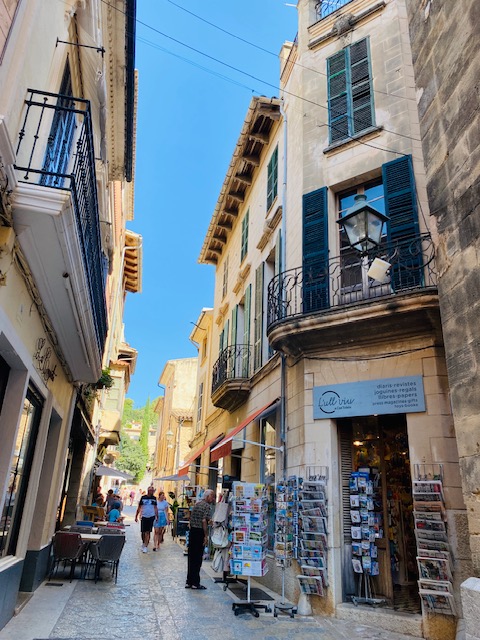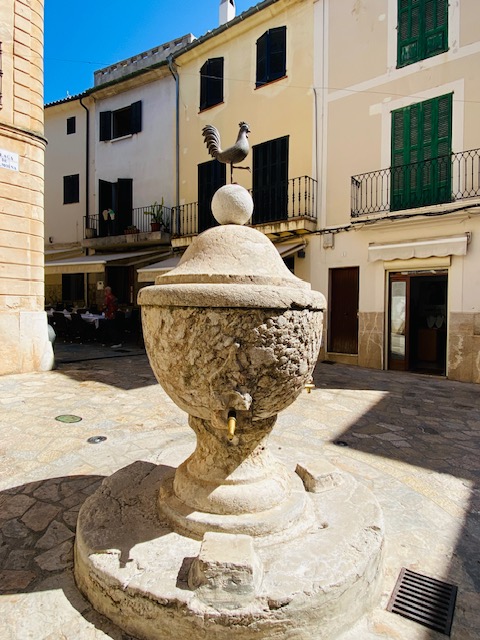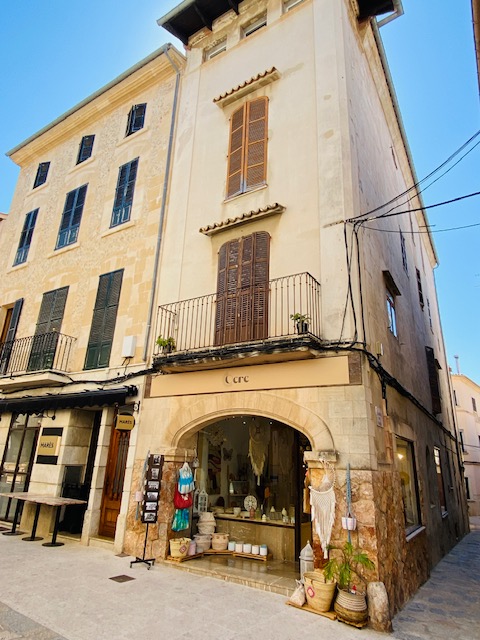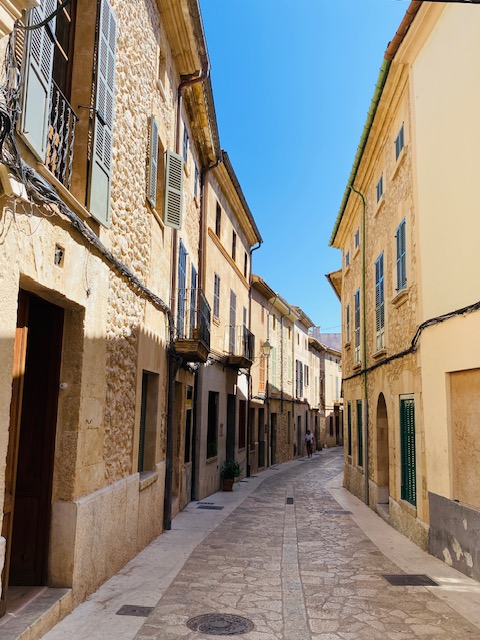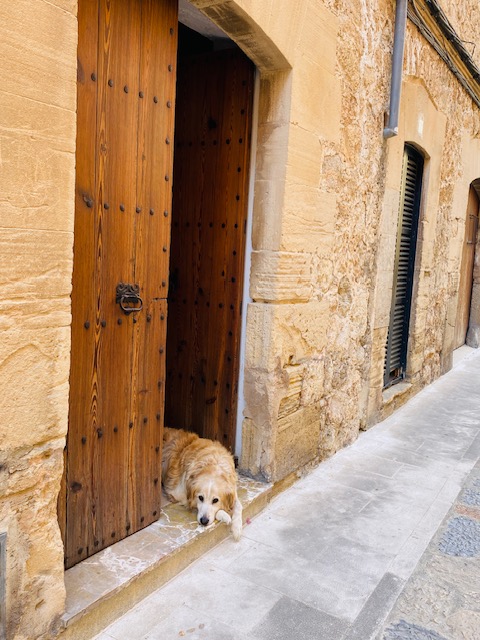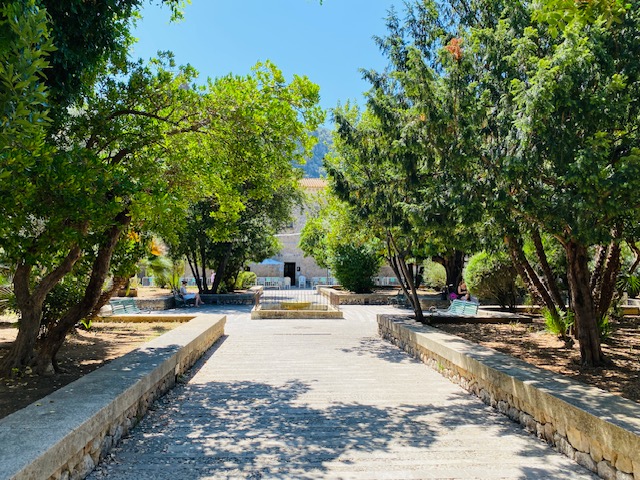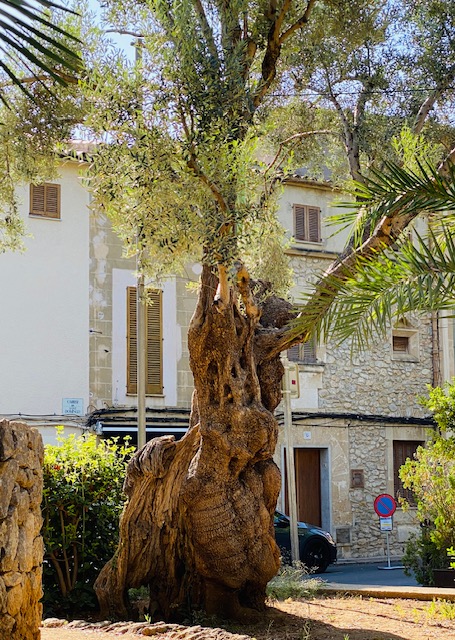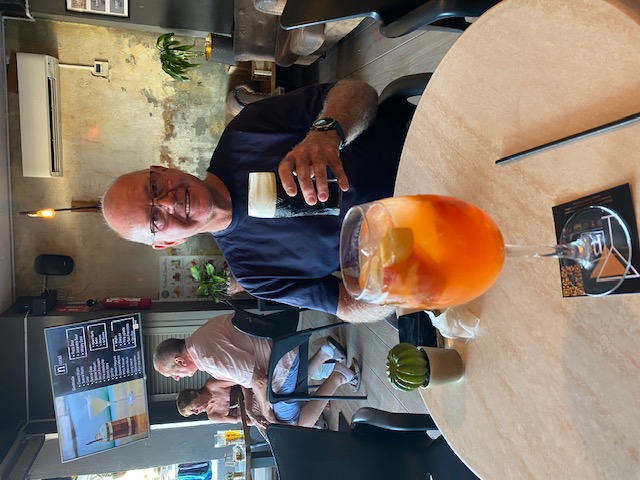Afterwards we took another bus trip; this time across the bay to Alcúdia and what another lovely surprise this turned out to be. As usual, we hadn’t done any research ahead of time and thought we were going to the other seaside beach area of Port d'Alcúdia and Platja d'Alcúdia, a 14 km / 8.7 mile long beach; anywhere would suffice rather than getting bounced around in the anchorage with all the weekend speedboat revellers out again. Instead, what we found was the UNESCO World Heritage Site of the historic and well preserved Old Town of Alcúdia, pedestrianised and encircled by its 14th Century medieval walls, with narrow streets and centuries-old buildings, dating back to the 13th Century.
Research revealed that the area where Alcúdia is located has been inhabited since the Bronze Age, but it was the arrival of the Romans, after they captured the island of Mallorca in 123 BC, using the beaches of Alcúdia Bay, that founded the cities of Palma and Pollentia.
However, as Rome lost its position as the dominant power in the western Mediterranean, Pollentia was abandoned and left in ruins, while the remaining population created a new town, Pollença. The remains of the ancient Roman city can be seen just outside the medieval walls.
In 1298, a Moorish farmstead, known then by the Arabic name of “Alkudja” and located very close to the ancient city of Pollentia, was bought by King James II of Aragon, following which the new town, Alcúdia, was founded.
A church, a graveyard, a house for priests, and a town square were created in the same year. The construction of the wall was also initiated at that time and completed in 1362, all of which we could see during our wanderings around the Old Town. Apparently the city plan that was created at the time remains the same for Alcúdia today and you can almost walk around the entire Old Town along the walls.
Land was given up in 1302 by the King of Mallorca, James III, to build the present day church, “Iglesia de St. Jaume d'Alcúdia” (Church of St. James of Alcúdia), a neo-Gothic style construction, built into the town’s restored medieval walls and which also houses “Capilla del Sant Crist” (Chapel of St Crist), built between 1675 and 1697 to honour Sant Crist, a consequence of the increasing devotion that Alcúdia and the neighbouring villages felt for Saint Crist, following a miracle in the area. With droughts persisting, the locals decided to carry the image of Sant Crist in a procession from Alcúdia to the Cave of Sant Martí begging for water in their prayers. The image of Sant Crist started to sweat drops of blood and water on their return to the city. A notary recorded the event, as the image sweated for three days. That year, bountiful rain fell and the yields were plentiful. Since then, Alcúdia has celabrated this miracle every three years, on the 26th July with a religious procession that passes through the town.
The chapel consists of a central dome and four side chapels, along with the altarpiece, which is a spectacular work of baroque art. In the centre of the altarpiece is an image of Saint James, the patron saint of Alcúdia.
After strolling around the Old Town, we returned to the main square and enjoyed a coffee at one of the many small restaurants, before taking the bus back to Port de Pollença.
Back onboard, after stopping to purchase a few provisions, the bulk of which we were leaving until tomorrow, Roy fixed the hatch in the aft port cabin that just decided to break a little while ago then spent what was left of the day lounging around with Elaine.
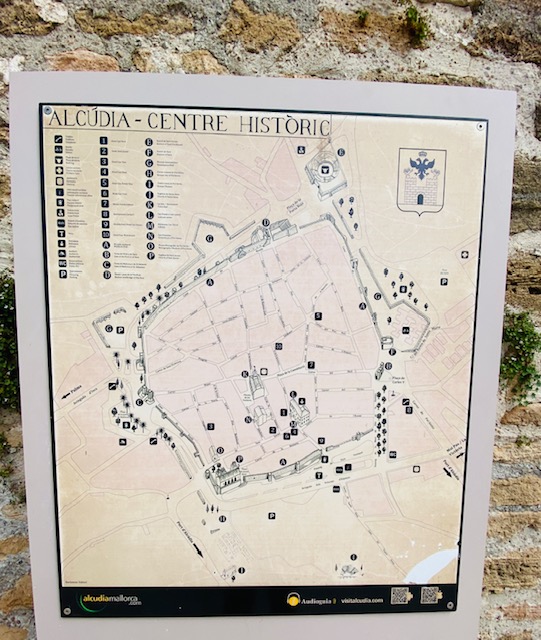
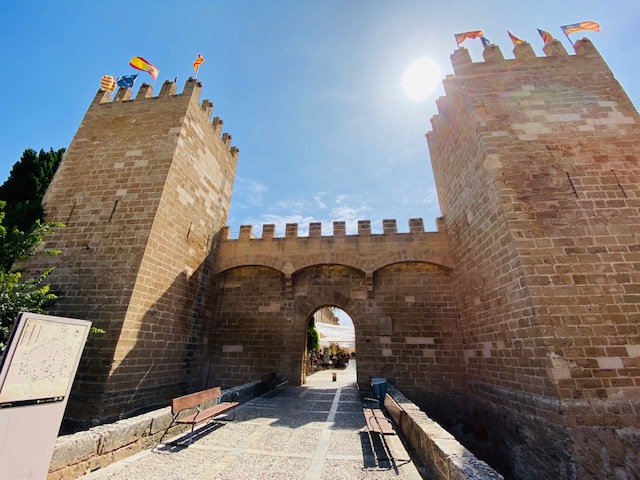
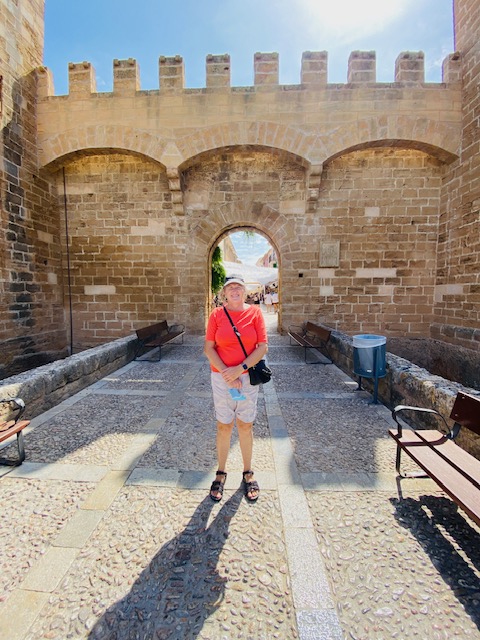
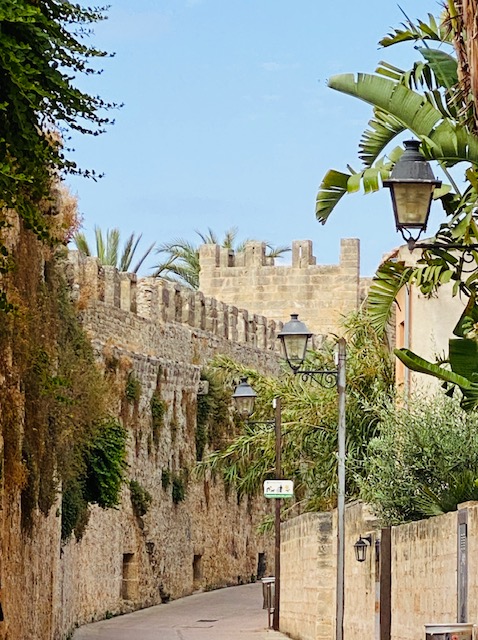
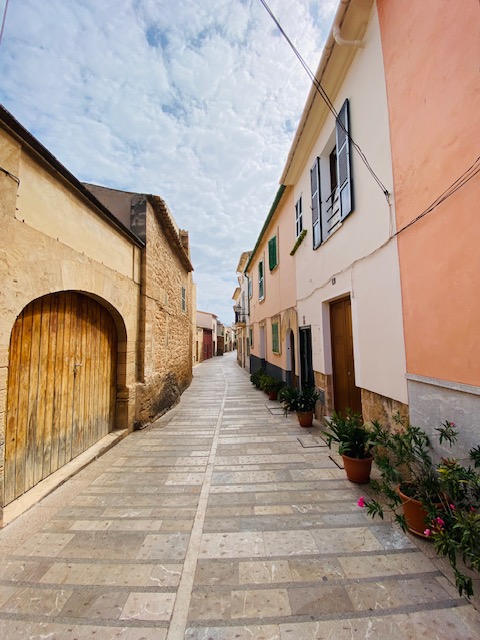
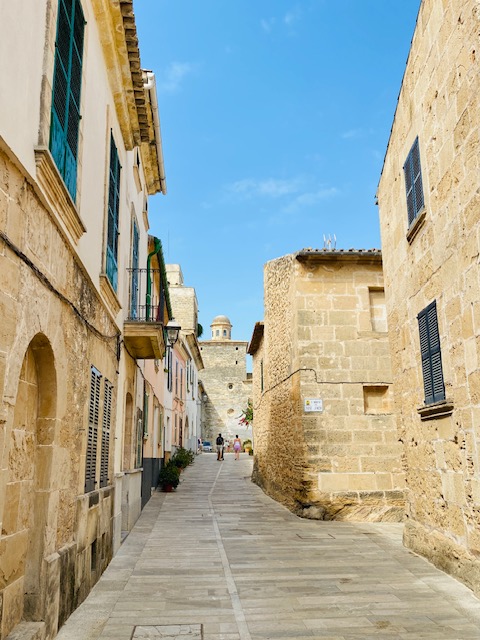
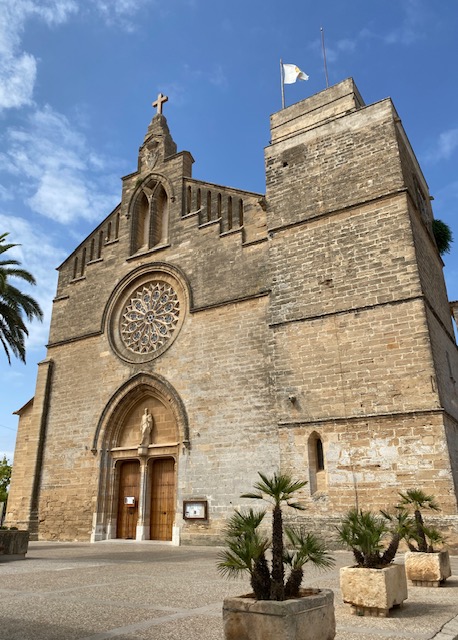
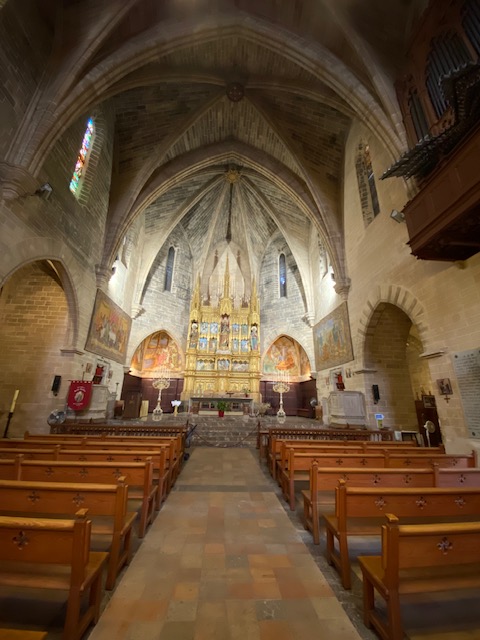
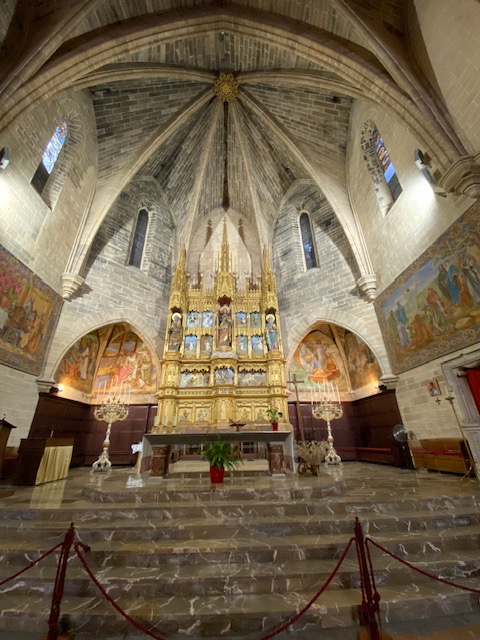
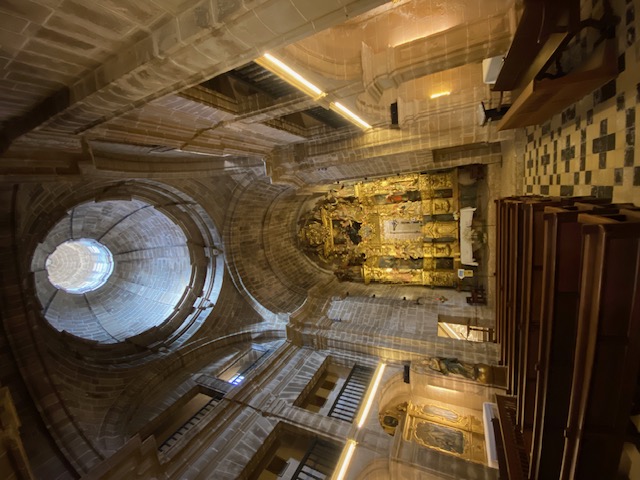
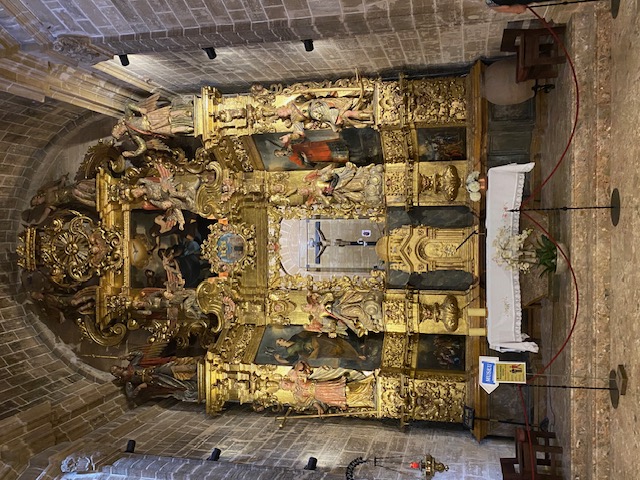
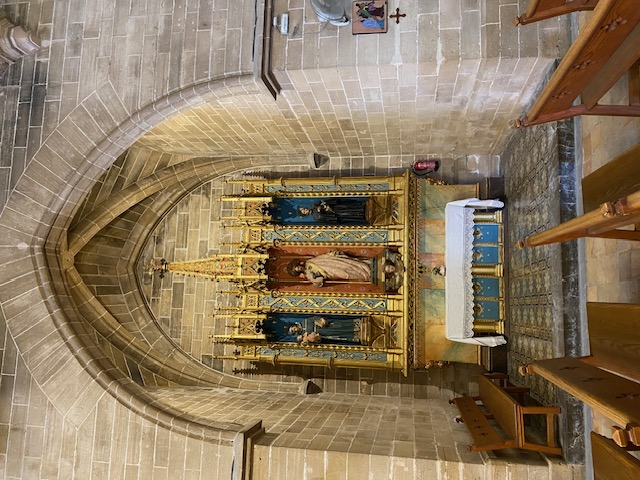
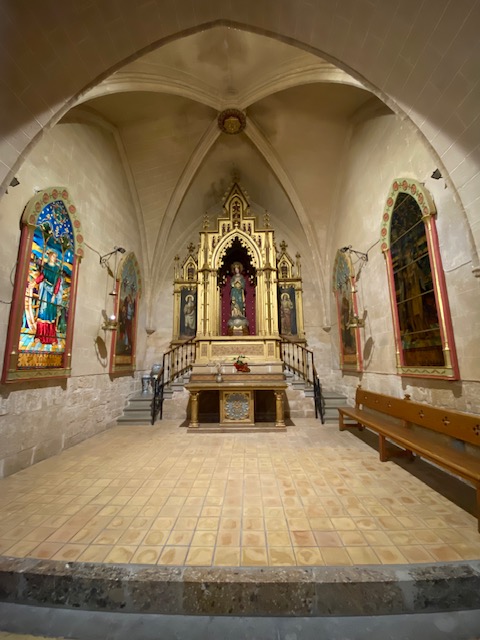
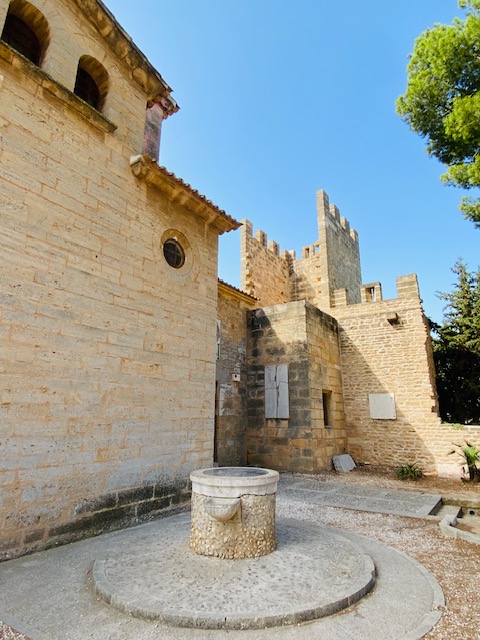
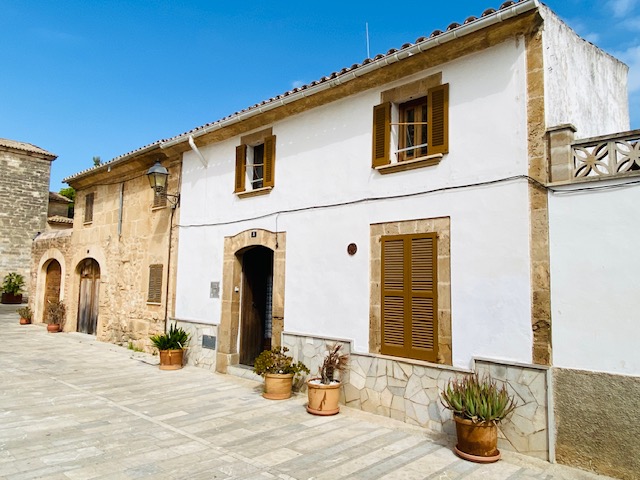
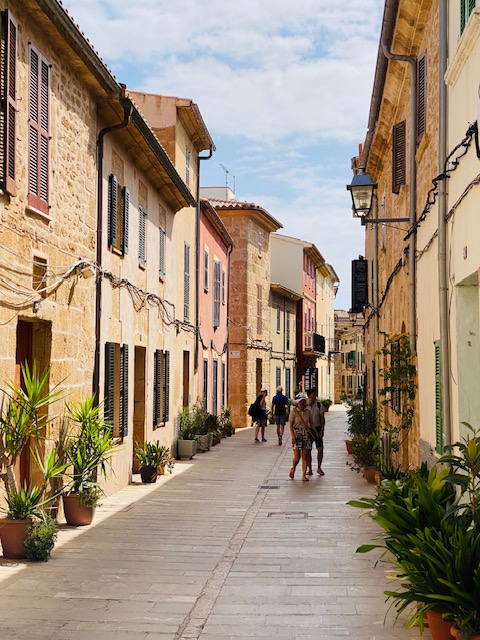
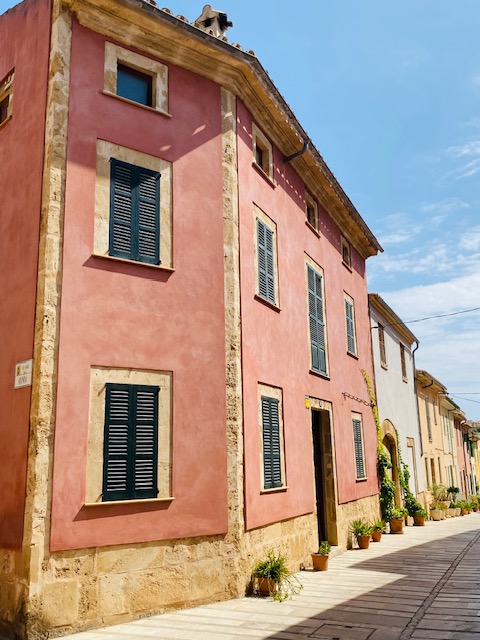
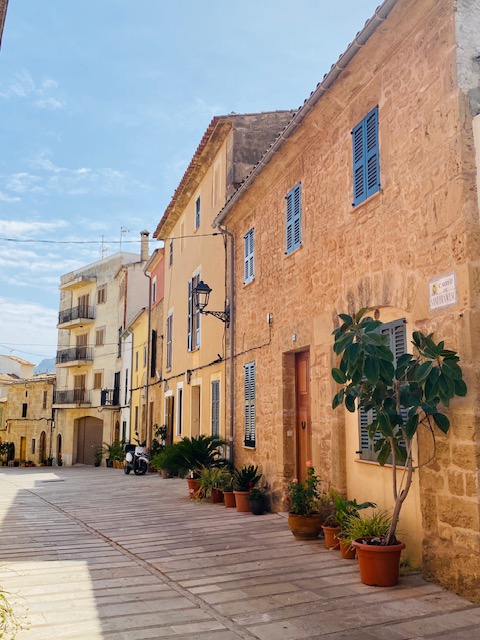
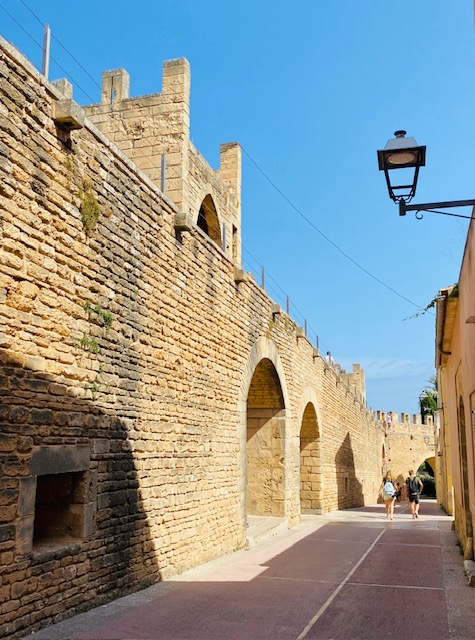
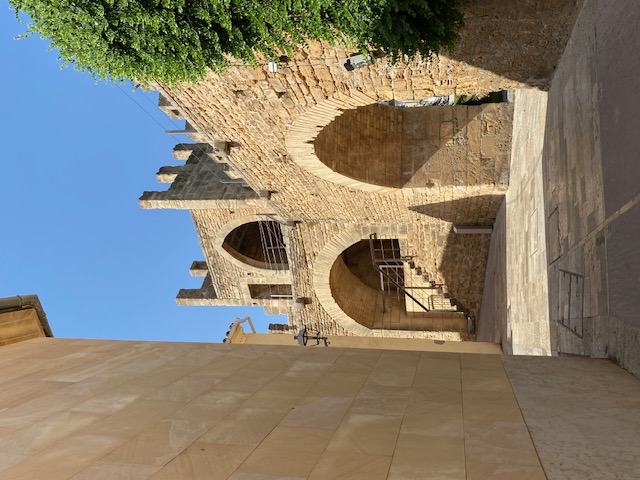
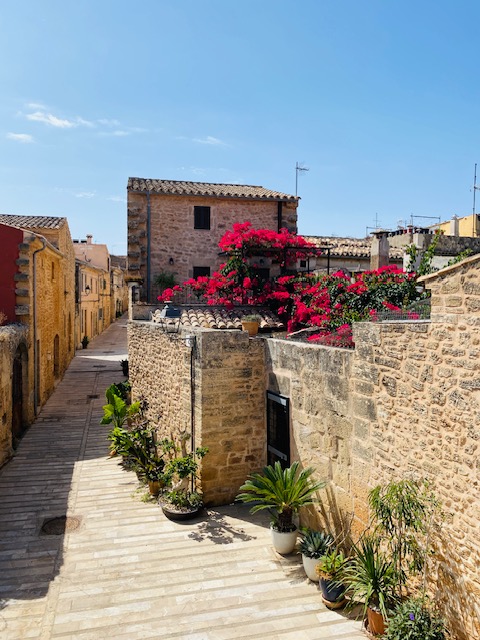
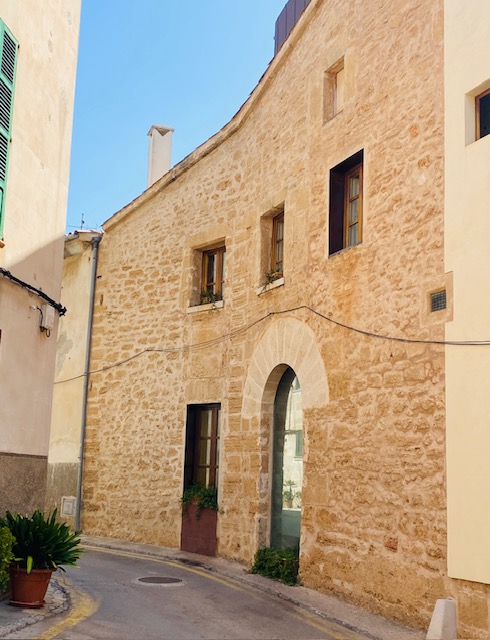
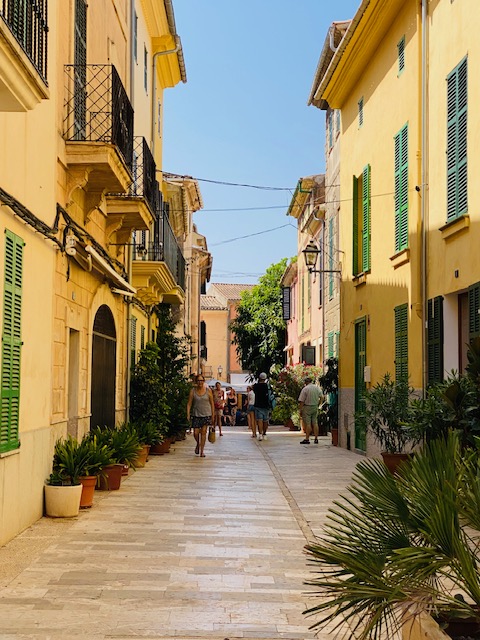
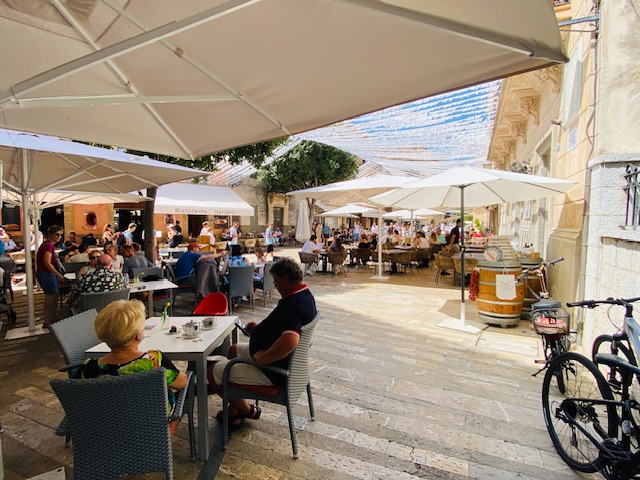
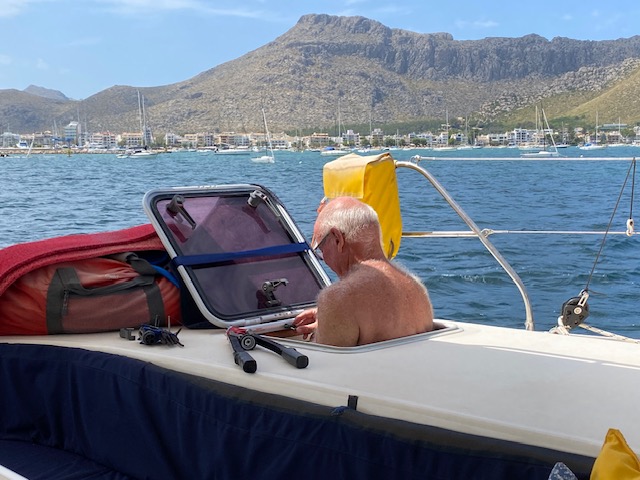
Then, while Roy completed a few maintenance tasks in preparation for our upcoming departure, including cleaning both engine compartments after doing the oil changes on Wednesday afternoon and checking the fluid levels on the generator, Elaine caught up on the blogs and catalogued our latest photographs. Surprisingly we still hadn’t had decent enough data connectivity to upload our photographs to the website, since she last tried in Italy. In fact, our coverage in Spain is worse than what we had in Italy; Fiji’s cellular infrastructure puts these places to shame actually.
Afterwards, we dinghied ashore and returned to the lounge of the Cultural Boutique Hotel and Restaurant to enjoy a coffee and baked delight. While we were there we chatted to a delightful couple, who were on their holiday from the UK.
With the weather looking rather menacing by the time we left the hotel lounge and temperatures having cooled down significantly, we decided to returned to Paw Paw rather than remain ashore. Fortunately nothing untoward developed from the weather, allowing us to return to shore for a dinner of spare ribs with a view, enjoyed, once again, at the Dakota Grill & Bar.
Before we made it ashore, though, we helped a young couple, who’d just arrived from Barcelona, after they ran out of fuel in their dinghy. To thank us for our efforts we received some fresh tuna which they’d caught en route to Mallorca. Apparently they’d caught so much fish their freezer was full; might explain why the orcas have migrated into the Mediterranean Sea.
Unbeknownst to us, however, the inclement weather was yet to arrive. While this anchorage is never calm during the day, primarily due to the churned up water created by the wakes of the numerous speedboats that power through the yachts all day, every day, it thankfully calms completely at night, allowing for a good night’s sleep, but not last night; we’d barely climbed into bed when the wind started howling from the south, the only direction that this bay is not protected from, creating quite a fetch, but stopped as quickly as it started. Unfortunately a southerly wind brings with it the red desert sand and heat, which made for a very uncomfortable night and covered Paw Paw in the red sand once again, creating another major cleanup task that neither of us can be bothered to deal with at this stage.
Then this morning, while we were getting ready for a morning walk along the waterfront, the wind increased suddenly again, blowing 18-22 Kts for most of the day, scuppering our plans. Instead we returned to bed for a morning nap, given we’d both tossed and turned all night.
Since we were yacht bound anyway, Roy took the opportunity to run the watermaker and Elaine managed to upload all our photographs, up to the end of June, to the website, after we switched service providers for the exercise. She also consolidated our daily blogs, discovering a slight error in the blog numbers, which she’ll fix at a later date.
A chat to Elaine’s folks and, more importantly, to her dad, sealed the day.
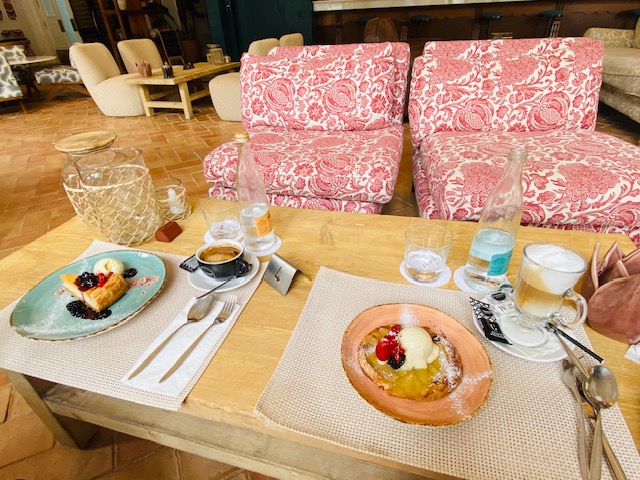
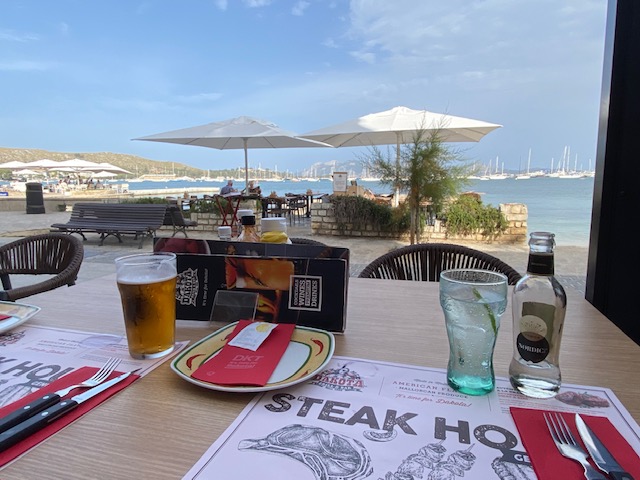
However, before we reached the bus stop, we were delighted to stumble upon a Morning Market in the town square of Port de Pollença, packed with stands of fresh produce, cheeses, olives, accessories, clothing, etc, which we would have loved to have browsed, but our other plans took precedence.
After our arrival in Palma, at the Estació Intermodal, the main bus terminal, we navigated the large facility to get the underground train service to Son Castelló in an industrial area of Palma, but not before we’d seen a completely contrasting landscape to the beautiful, green, lush surroundings of the “Serra de Tramuntara” (Tramuntara mountains), which we thoroughly enjoyed yesterday; this was flat, dry and nondescript, although we did see evidence of agriculture and industry.
Unfortunately the company Roy had contacted to source the oil filters we needed had two different addresses and, as per Murphy’s Law, we walked in the sweltering heat to their sail loft erroneously. When we eventually found the Yanmar outfit, we’d essentially walked back two stops on the train service. Thankfully, after getting the oil filters, from there it was a short walk to the nearest underground station to return to the city centre, where we ventured above ground.
Sadly, our first impressions, formed from our bus ride into the city, didn’t change when we popped out at street level. The graffiti we’d seen everywhere was still evident all around us, making everything look rather grubby and economically depressed, more so than Napoli, the latter impacted more by the garbage that we’d seen everywhere rather than graffiti. We did, however, get a glimpse into local life and the multicultural diversity of the island with the various ethnicities who got on and off the bus versus hanging out in the upmarket tourist places only. What did impress us was the bus service and underground train service, a major logistical undertaking which ran like clockwork, and one we couldn’t fault in any way.
Needing the loo desperately by this point, though, after the gallons of water we’d drank to stay hydrated, we found a little cafe, La Isle del Cafe, tucked away in one of the backstreets and away from the madding crowd, where we enjoyed a coffee and baked delight, accompanied by copious amounts of more water; it felt like our eyeballs were floating with the amount of water we’d consumed during this heatwave, but it was absolutely necessary.
Our return bus ride got us back to Paw Paw around 1500, following which Roy completed the oil changes and replaced the oil filters on both engines, while Elaine chatted to her sister, Dianne. Keenan also called to catch up, all of which made for a rather late dinner, but the highlight of the day was receiving a photograph of our granddaughter’s first day of high school. It didn’t seem that long ago that Elaine attended her kindergarten graduation and now she was heading to high school and what a beautiful young lady, inside and out, she has grown into.
Thankfully the wind was blowing when we returned to Port de Pollença, cooling the temperatures down a little bit, but we, nonetheless, switched on the air-conditioning to enjoy the cool comfort before bedtime after another very hot day.
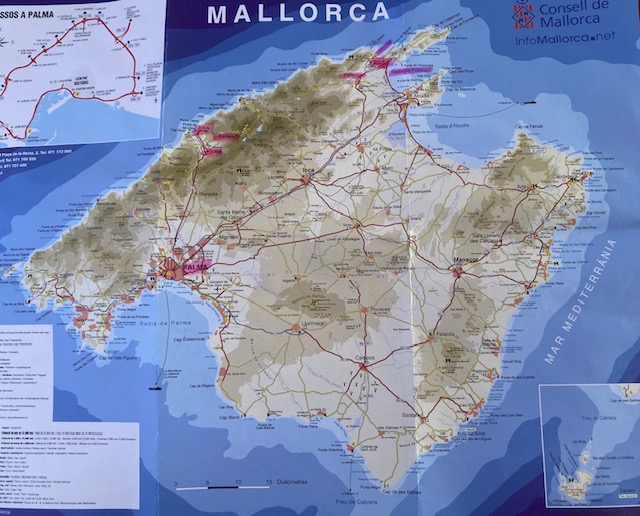
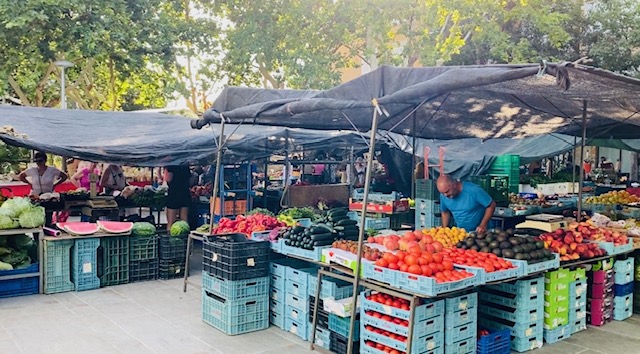
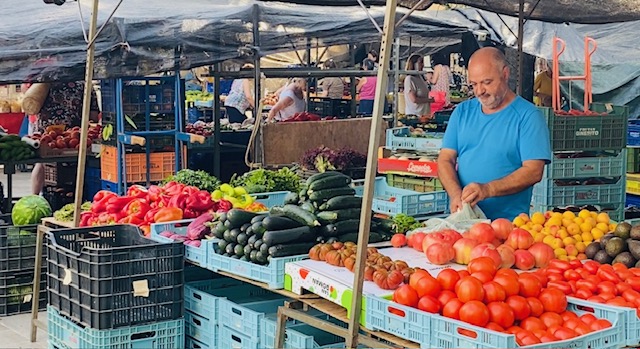
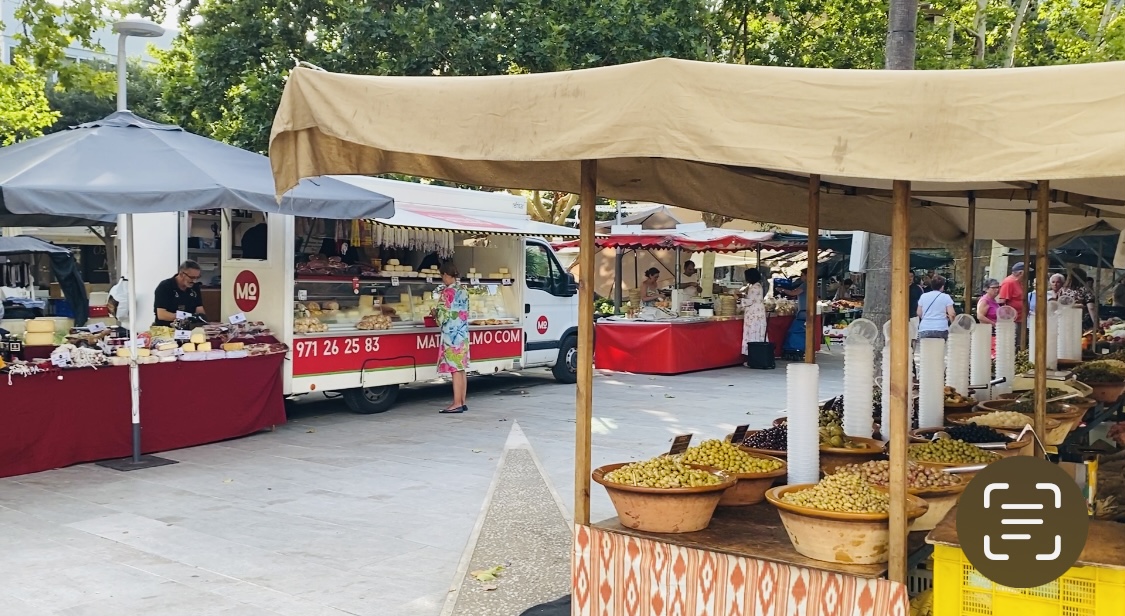
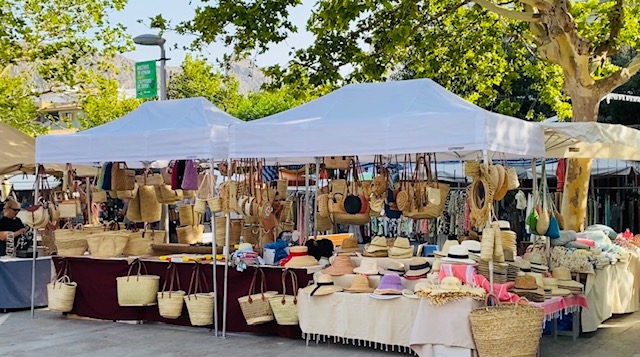
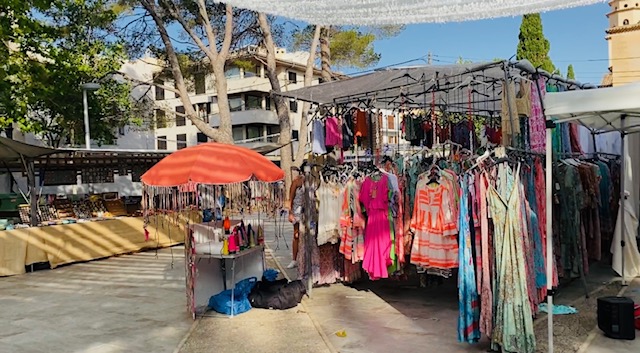
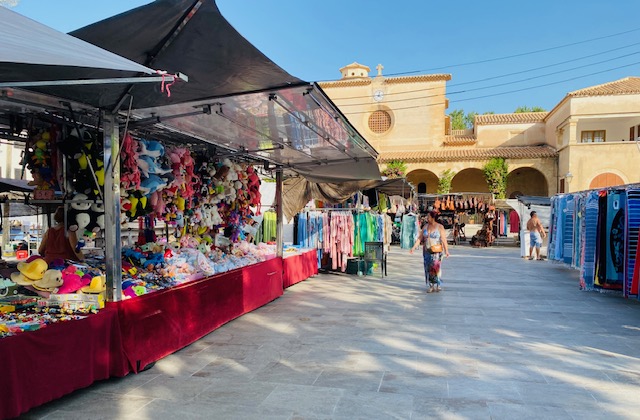
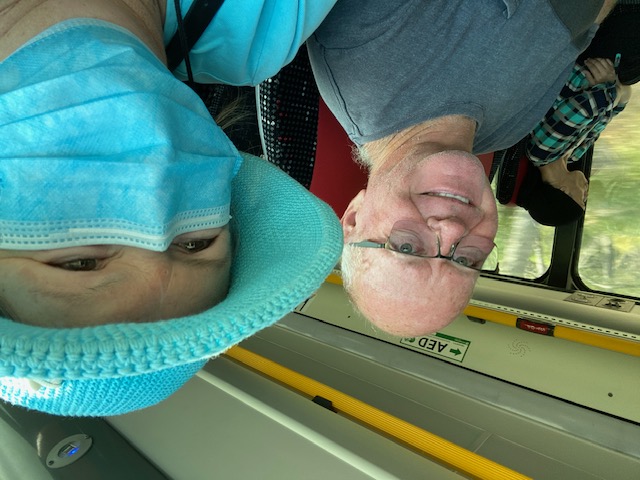
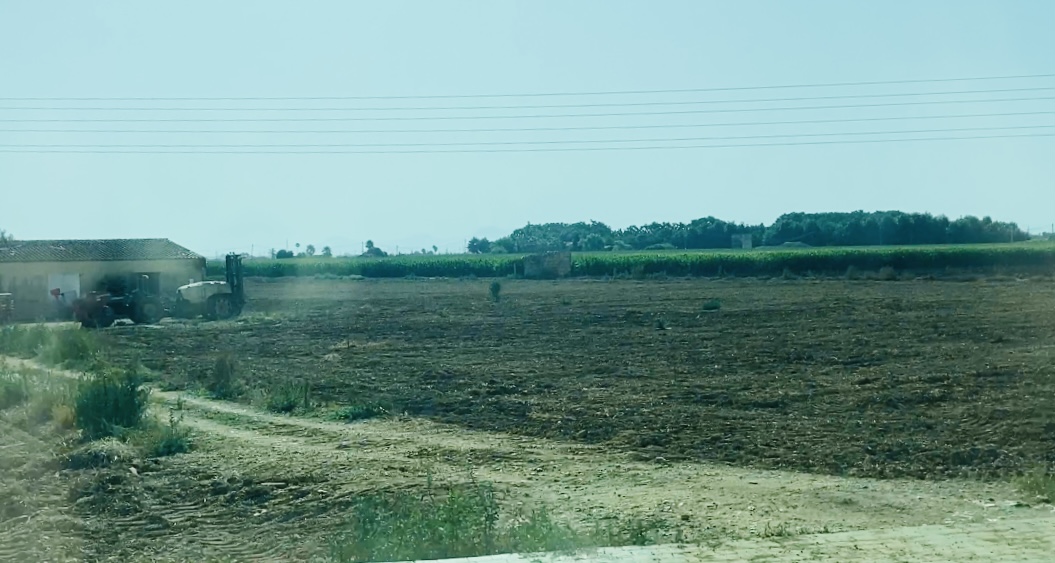
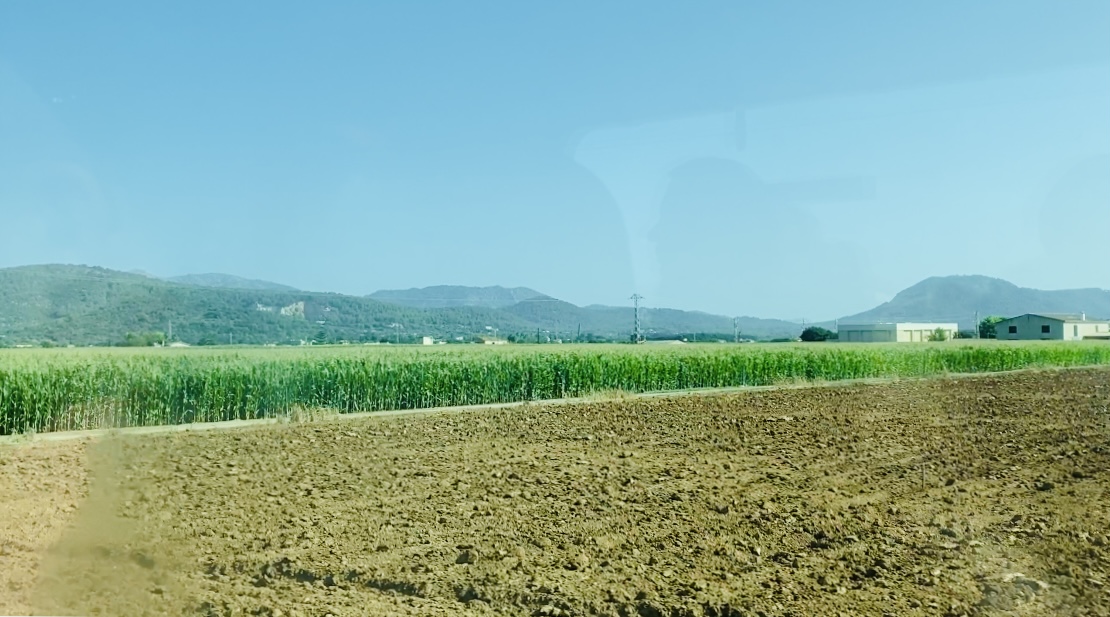
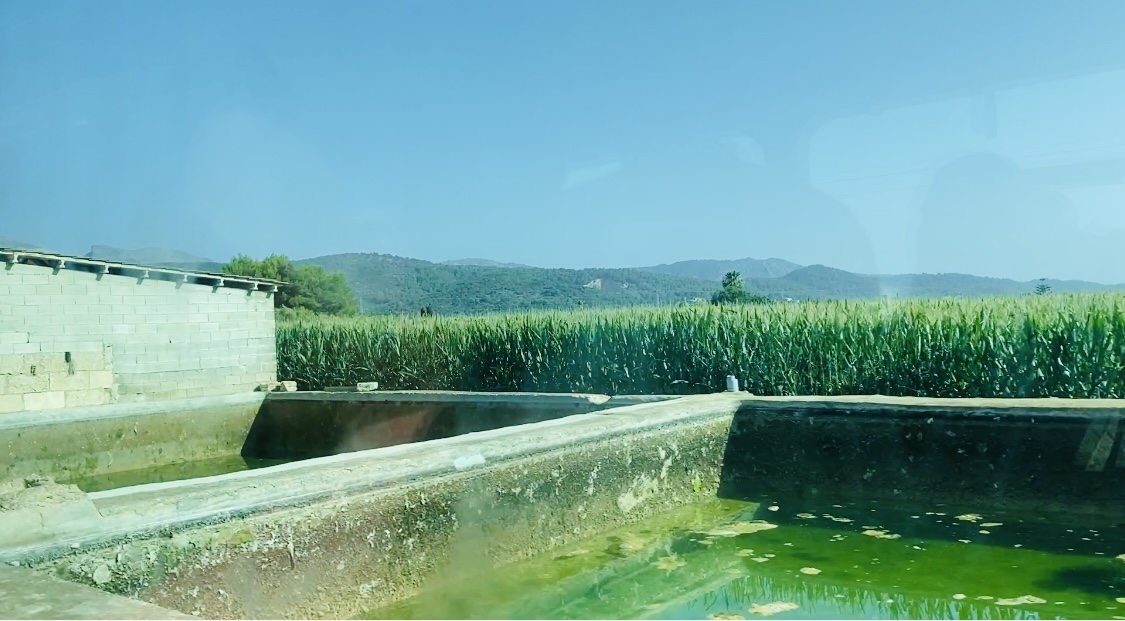
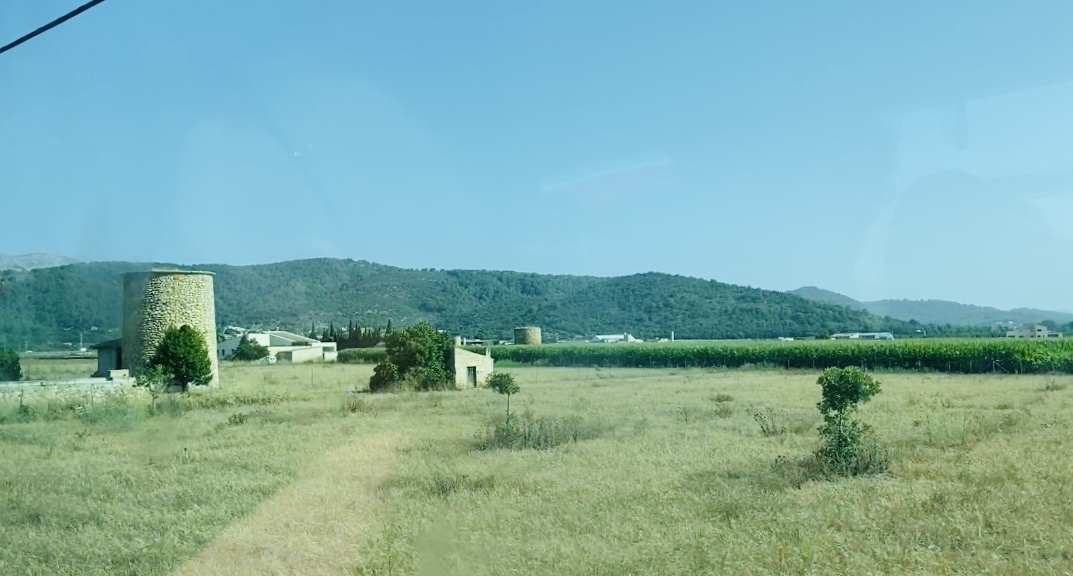
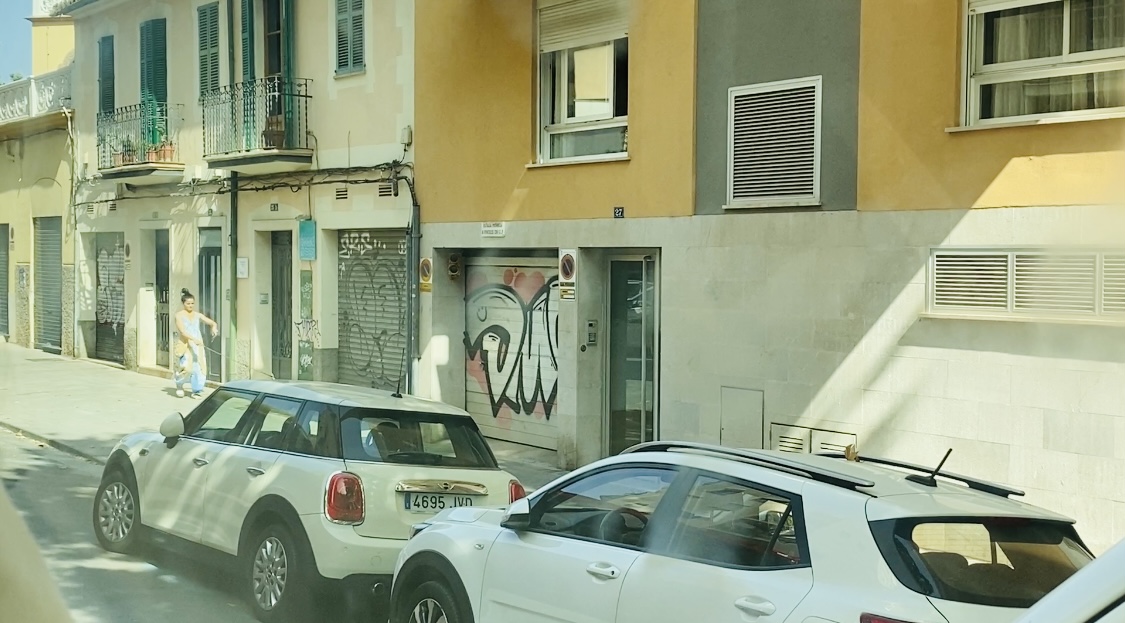
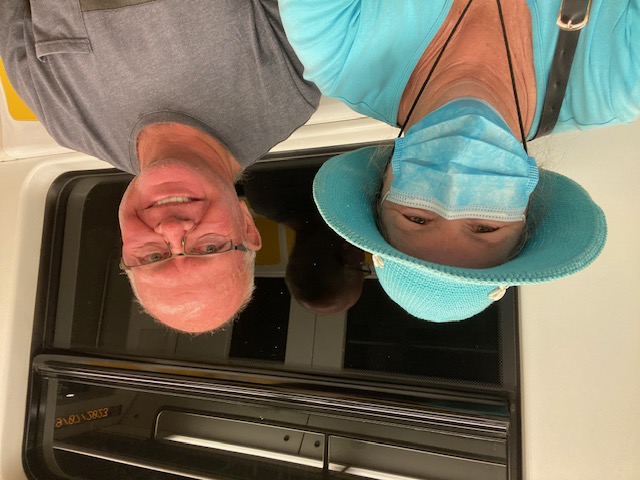
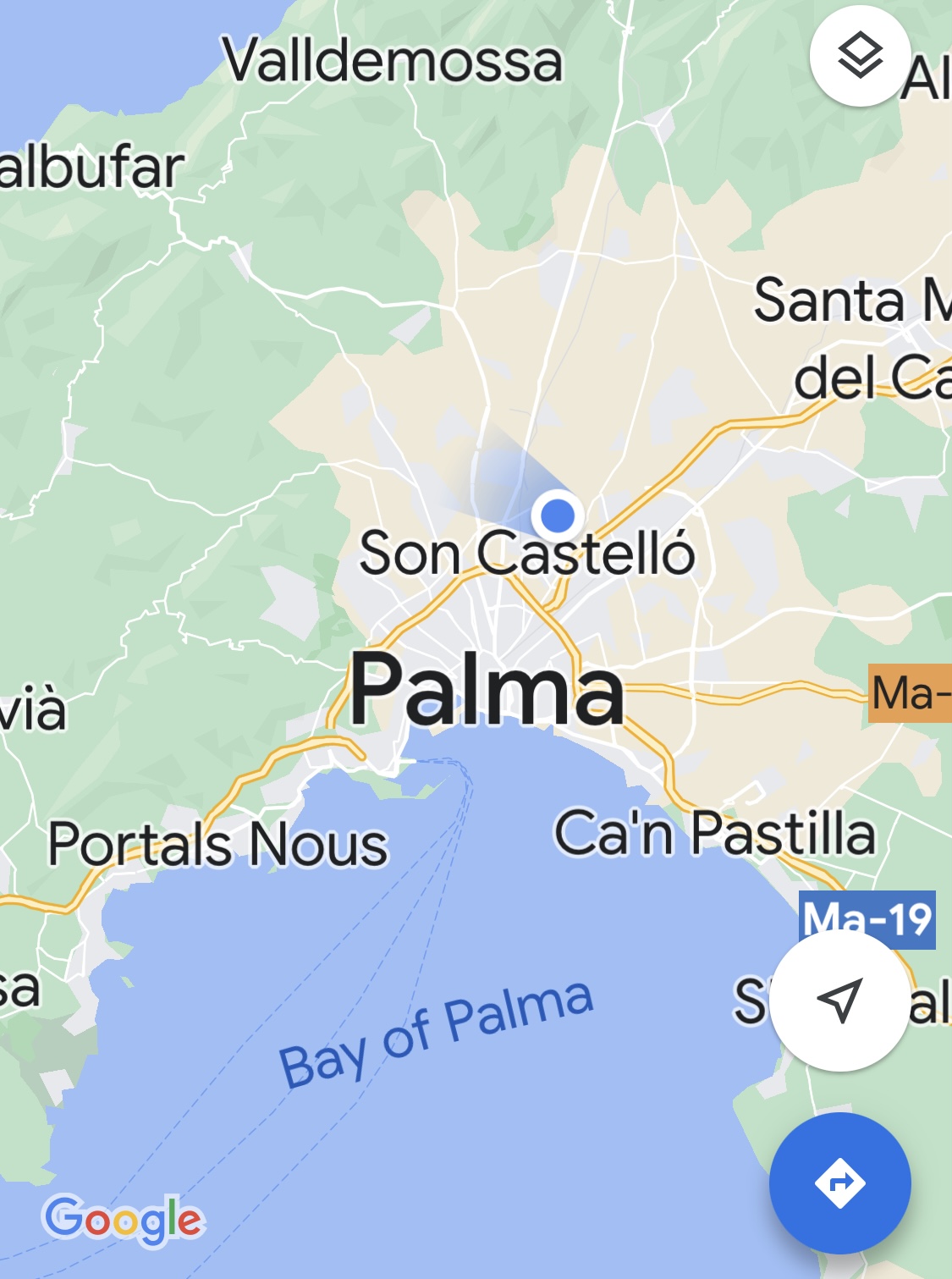
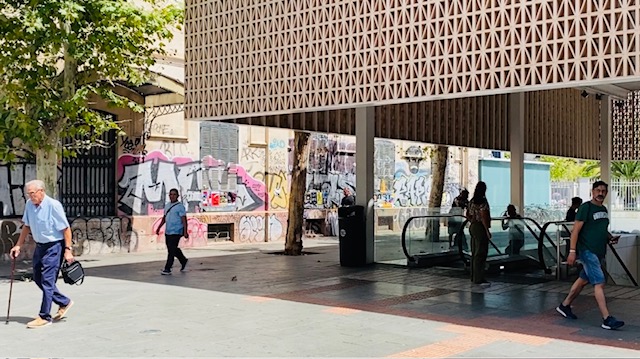
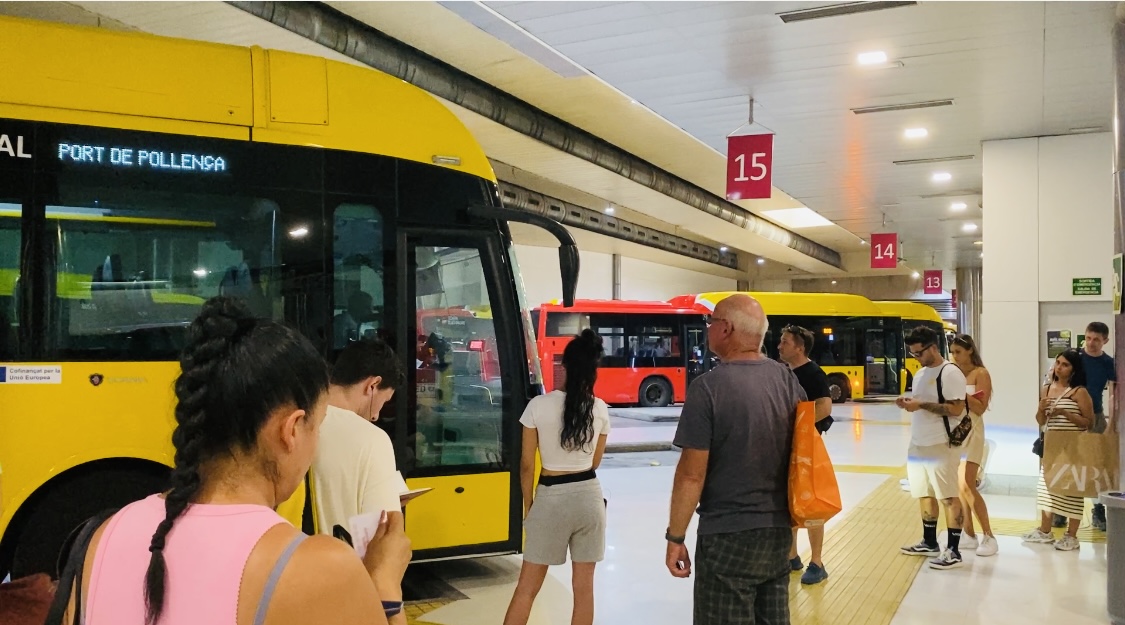
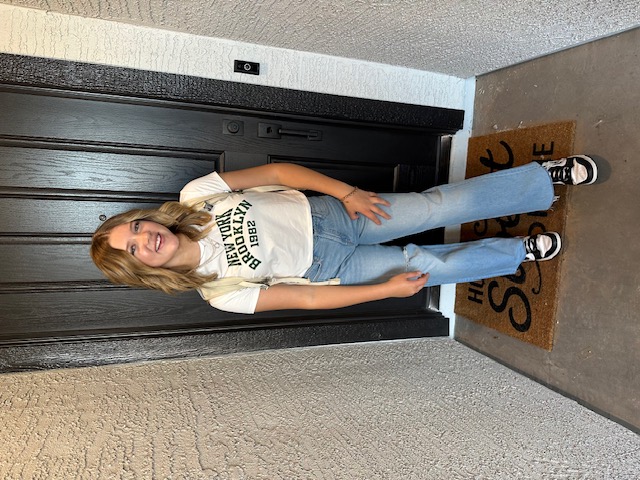
Since we were heading into and over the “Serra de Tramuntara” (Tramuntara mountains), we were escaping the heat and enjoyed stunning scenery along the way, including lush woodlands, a beautiful lake and Puig de Massanella, the second highest peak on the island, all in the comfort of a rather luxurious air-conditioned coach; much nicer than we expected for local transportation.
We also had the opportunity to see the vineyards of Mortitx from a distance and have a brief stop in “Santuari de Lluc”, a monastery and the most important pilgrimage site on Mallorca, founded in the 13th Century after a Moorish shepherd found a statue of the Virgin Mary on the site where the monastery was then erected. It is also known for its boys’ choir, “Els Blauets”, founded in 1531.
Today, besides a botanical garden trail, containing a small exposition on preserving the environment of the mountain region, a boarding school and a number of tourist-orientated facilities, a night walk from Palma to the sanctuary takes place every year during the first weekend in August, leaving from “Plaça Güell” in the capital. The cells of the former monks can also be rented by visitors.
It was close to lunchtime by the time we arrived in the mountainous village of Fornalutx, but it was well worth the wait. The entire village is built from the surrounding stone with red roof tiles and most windows of the buildings having green painted wooden shutters; not surprising that it is considered the prettiest village on the island. It was really beautiful.
Built on different levels, many of the higher streets are pedestrianised and cobbled, with grassy paths leading off into the orchards and farms to the north. From our vantage point we could see the orange and lemon orchards as well as the olive groves higher up the mountain side, with some of the latter trees more than a thousand years old.
This village, set in the mountainous terrain, is considered one of the best examples of how to make optimum use of the natural landscape by building hillside terraces from the available stone and taking advantage of the woodland areas and available water supplies, coupled with the use of ancient growing techniques to harvest the olive trees and fruit orchards, all of which lead to the area being declared a UNESCO World Heritage Site in 2011.
At the centre of Fornalutx is the “Plaça d'Espanya”, surrounded by cafés and a general store and where we had a very tasty lunch at a little restaurant called Can Benet, after wandering the narrow streets of the village.
Afterwards we made our way back to the bus stop for our return trip to Sóller and to enjoy our next adventure; Mallorca’s first, and only, electrical tram, to enjoy the sights of the Sóller Valley, with its orange orchards, on the way to Port de Sóller. Getting to the tram station, though, was a rather interesting trek through the deserted backstreets of Sóller, passing “Jardi Botànic de Sóller” and eventually stumbling into the town centre.
After arriving in Port de Sóller, unfortunately, our timing was a little off and we missed our return bus ride back to Port de Pollença by a few seconds; the bus was literally pulling away as we approached the bus stop, making for a rather hot, long wait for the next one, which got us back to Paw Paw well after 2100, but not before whiling away a few hours on the waterfront of Port de Sóller and enjoying a cold beverage or two.
Although we were both tired and hot by the time we got back to Paw Paw, it had been a wonderful day of exploring Mallorca Island. Switching on the air-conditioners onboard to cool ourselves down, as well as Paw Paw, though, was a necessity before enjoying a cold shower and crawling into our beds.
Today, after breakfast, we dinghied ashore and hopped on the bus to Sóller, situated in the northwest region of Mallorca Island. Our specific destination, however, was the picturesque village of Fornalutx, which required a connecting local bus service.
Since we were heading into and over the “Serra de Tramuntara” (Tramuntara mountains), we were escaping the heat and enjoyed stunning scenery along the way, including lush woodlands, a beautiful lake and Puig de Massanella, the second highest peak on the island, all in the comfort of a rather luxurious air-conditioned coach; much nicer than we expected for local transportation.
We also had the opportunity to see the vineyards of Mortitx from a distance and have a brief stop in “Santuari de Lluc”, a monastery and the most important pilgrimage site on Mallorca, founded in the 13th Century after a Moorish shepherd found a statue of the Virgin Mary on the site where the monastery was then erected. It is also known for its boys’ choir, “Els Blauets”, founded in 1531.
Today, besides a botanical garden trail, containing a small exposition on preserving the environment of the mountain region, a boarding school and a number of tourist-orientated facilities, a night walk from Palma to the sanctuary takes place every year during the first weekend in August, leaving from “Plaça Güell” in the capital. The cells of the former monks can also be rented by visitors.
It was close to lunchtime by the time we arrived in the mountainous village of Fornalutx, but it was well worth the wait. The entire village is built from the surrounding stone with red roof tiles and most windows of the buildings having green painted wooden shutters; not surprising that it is considered the prettiest village on the island. It was really beautiful.
Built on different levels, many of the higher streets are pedestrianised and cobbled, with grassy paths leading off into the orchards and farms to the north. From our vantage point we could see the orange and lemon orchards as well as the olive groves higher up the mountain side, with some of the latter trees more than a thousand years old.
This village, set in the mountainous terrain, is considered one of the best examples of how to make optimum use of the natural landscape by building hillside terraces from the available stone and taking advantage of the woodland areas and available water supplies, coupled with the use of ancient growing techniques to harvest the olive trees and fruit orchards, all of which lead to the area being declared a UNESCO World Heritage Site in 2011.
At the centre of Fornalutx is the “Plaça d'Espanya”, surrounded by cafés and a general store and where we had a very tasty lunch at a little restaurant called Can Benet, after wandering the narrow streets of the village.
Afterwards we made our way back to the bus stop for our return trip to Sóller and to enjoy our next adventure; Mallorca’s first, and only, electrical tram, to enjoy the sights of the Sóller Valley, with its orange orchards, on the way to Port de Sóller. Getting to the tram station, though, was a rather interesting trek through the deserted backstreets of Sóller, passing “Jardi Botànic de Sóller” and eventually stumbling into the town centre.
After arriving in Port de Sóller, unfortunately, our timing was a little off and we missed our return bus ride back to Port de Pollença by a few seconds; the bus was literally pulling away as we approached the bus stop, making for a rather hot, long wait for the next one, which got us back to Paw Paw well after 2100, but not before whiling away a few hours on the waterfront of Port de Sóller and enjoying a cold beverage or two.
Although we were both tired and hot by the time we got back to Paw Paw, it had been a wonderful day of exploring Mallorca Island. Switching on the air-conditioners onboard to cool ourselves down, as well as Paw Paw, though, was a necessity before enjoying a cold shower and crawling into our beds.
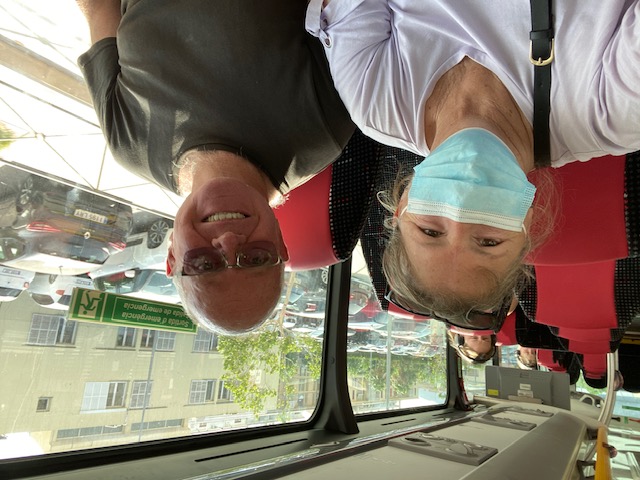
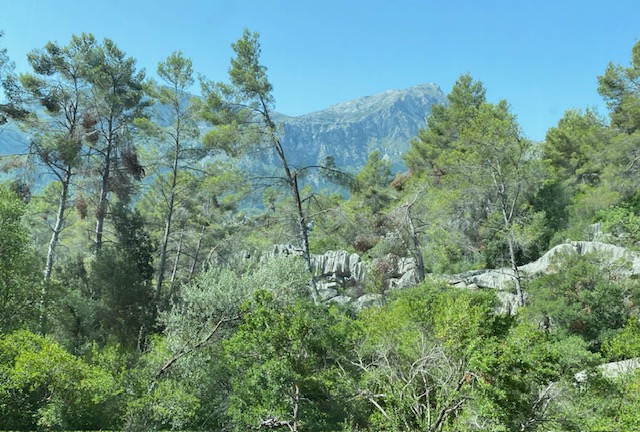
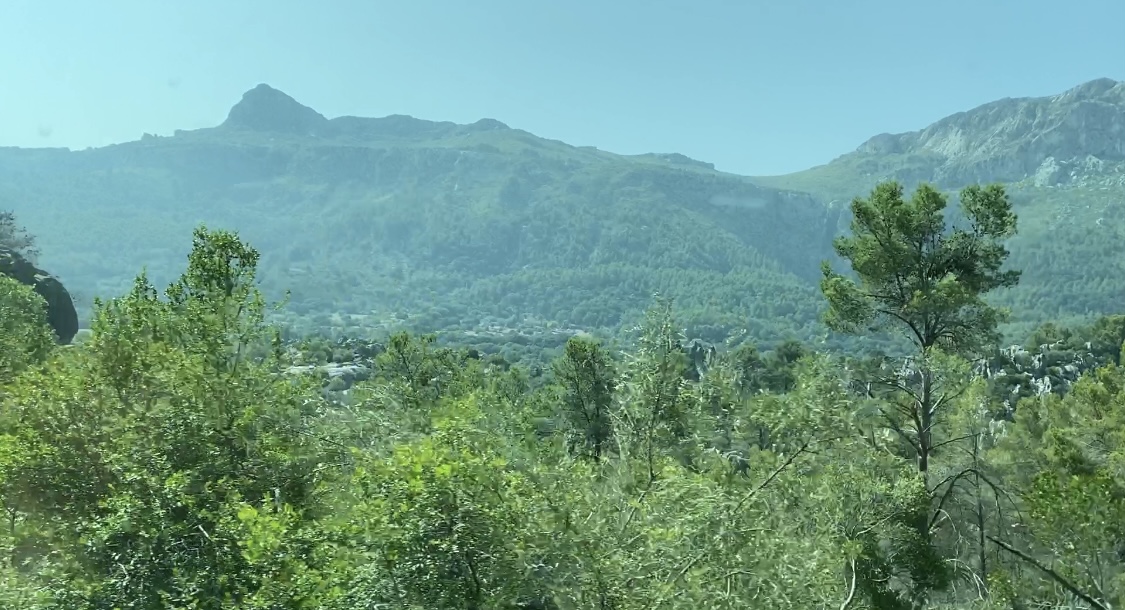
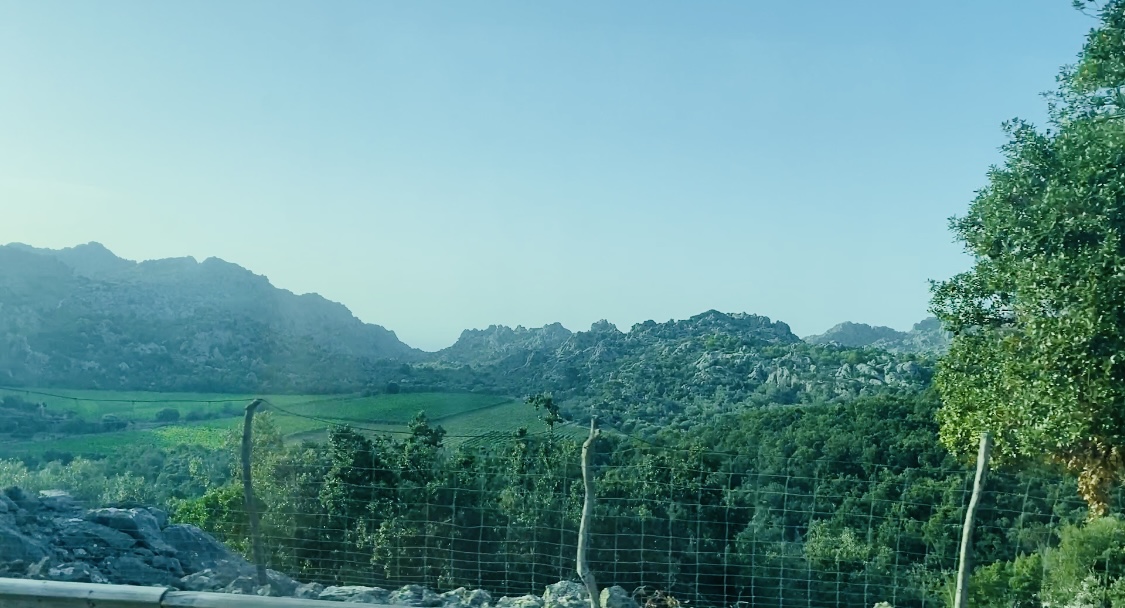
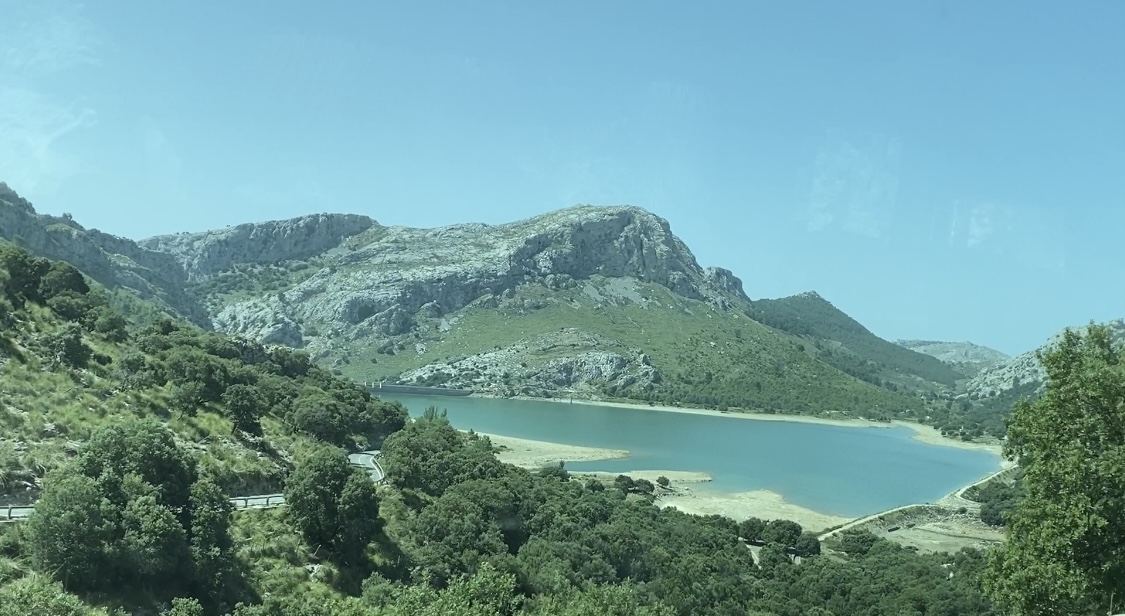
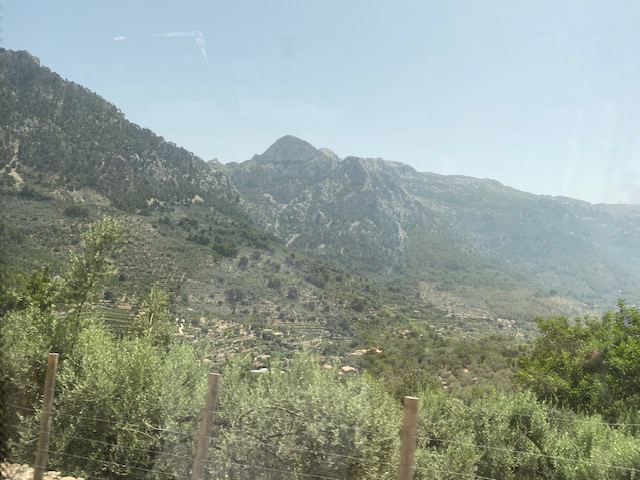
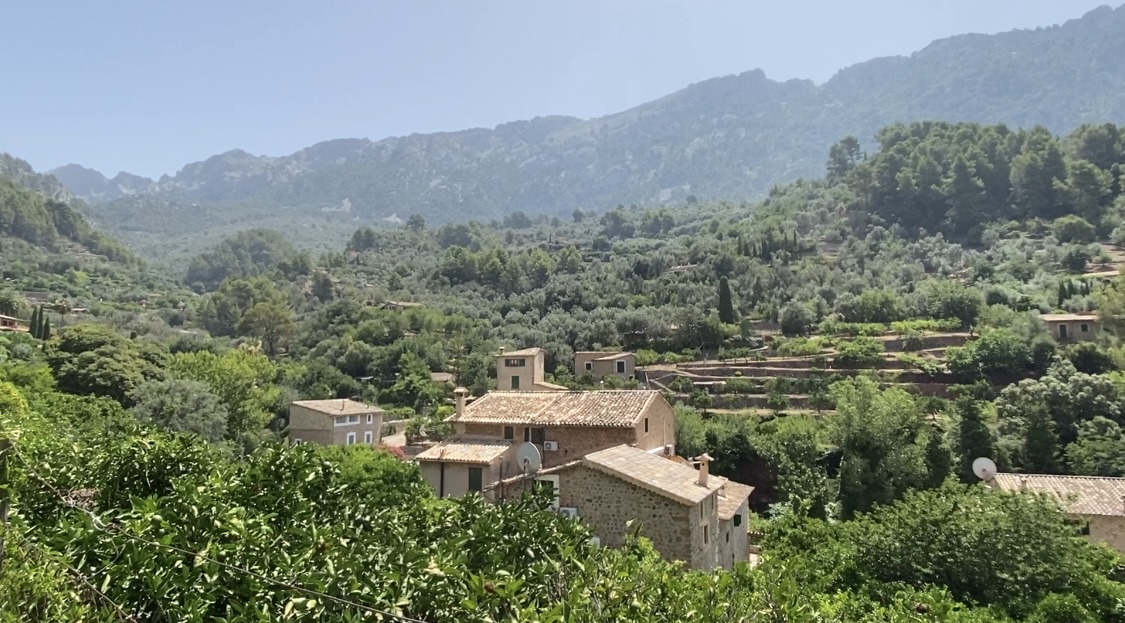
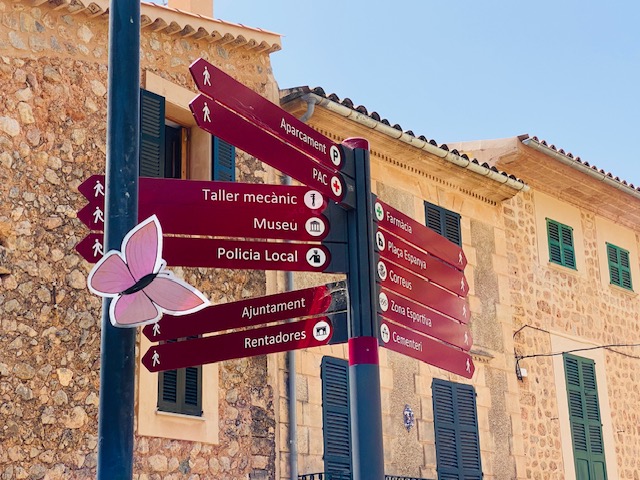
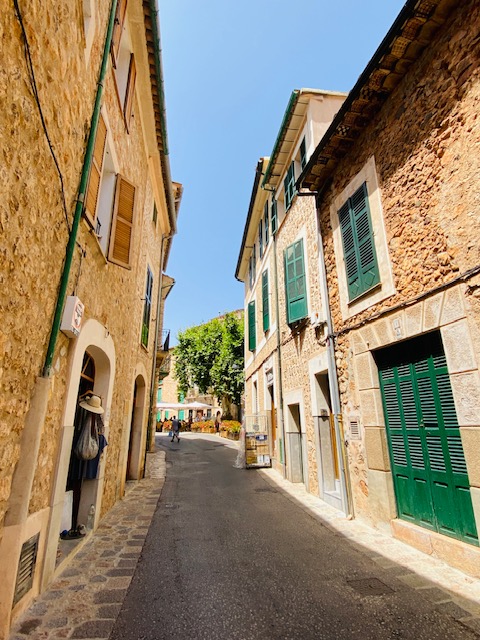
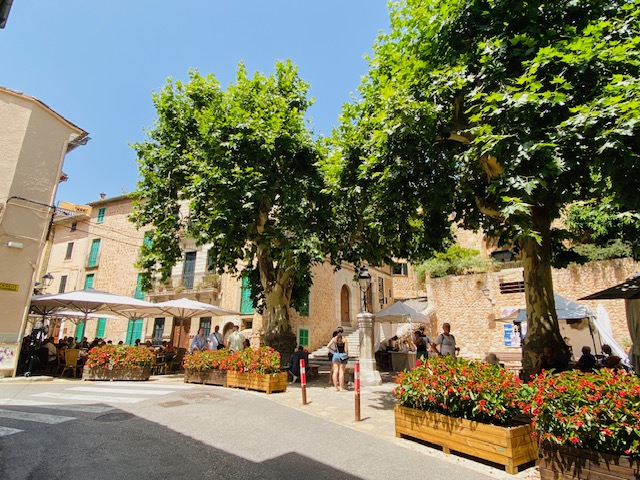
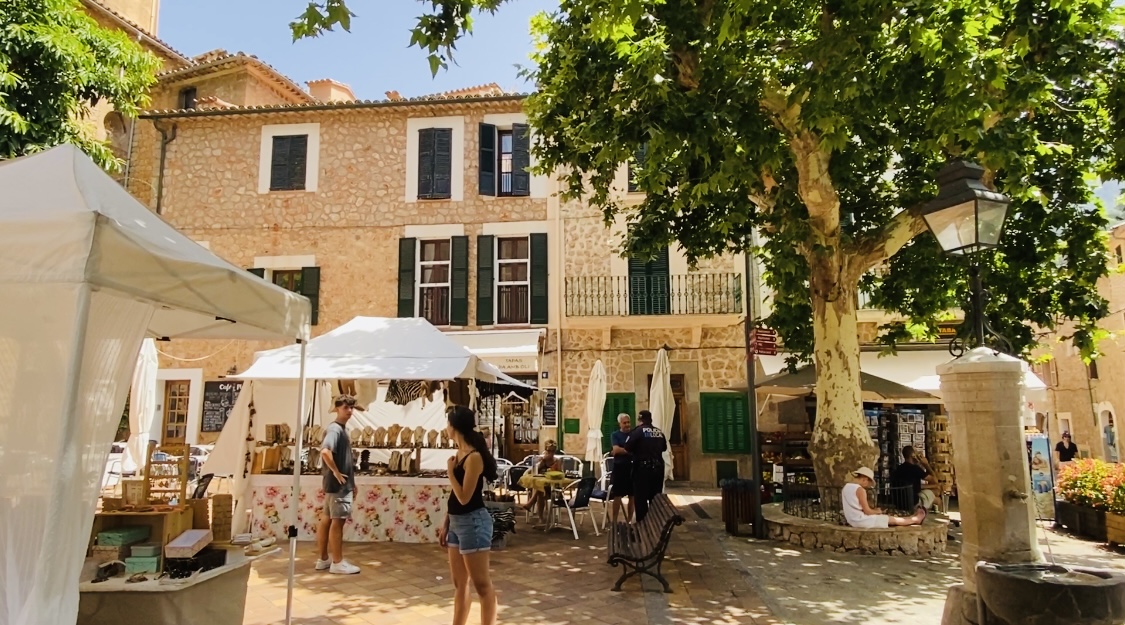
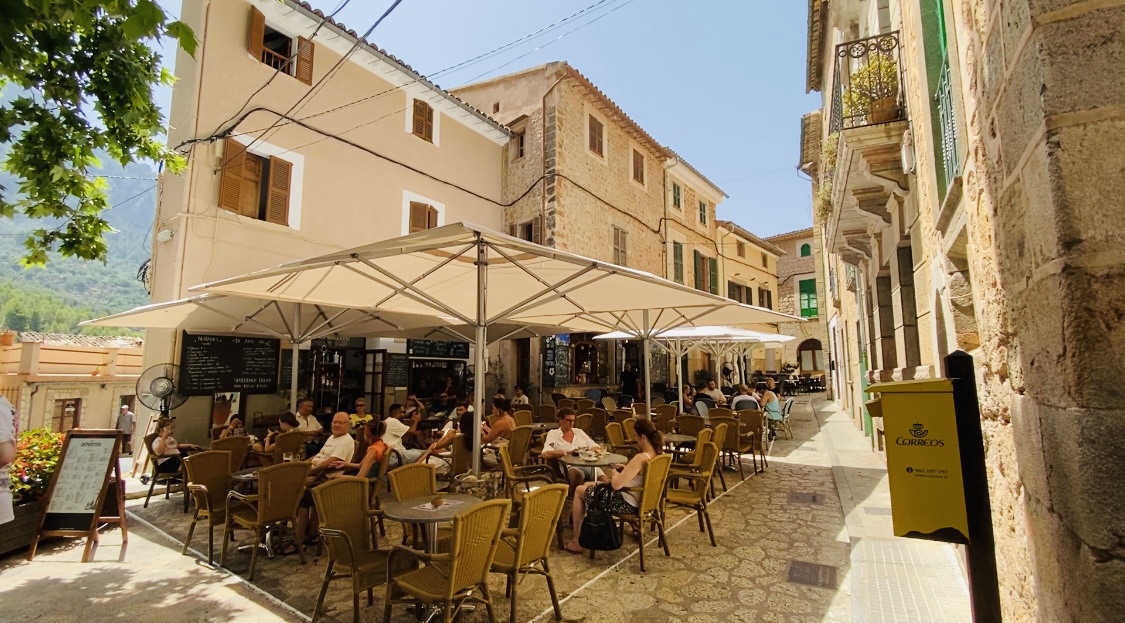
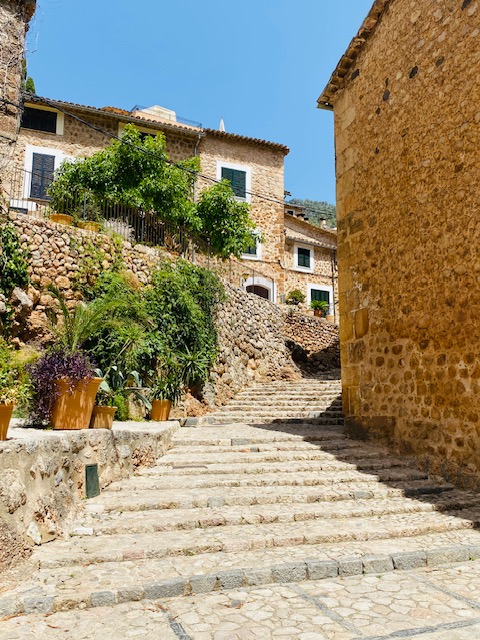
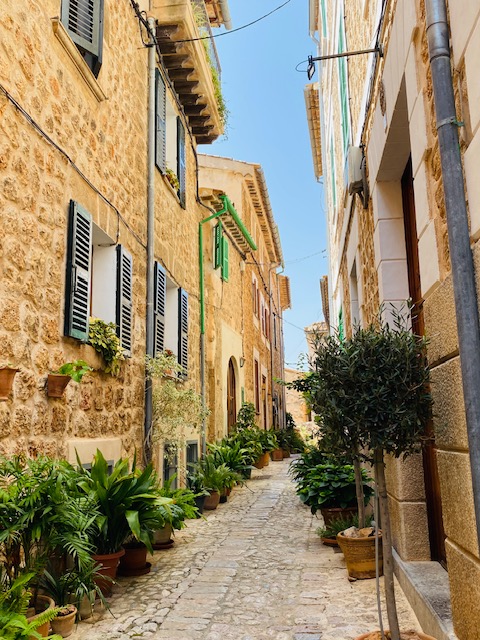
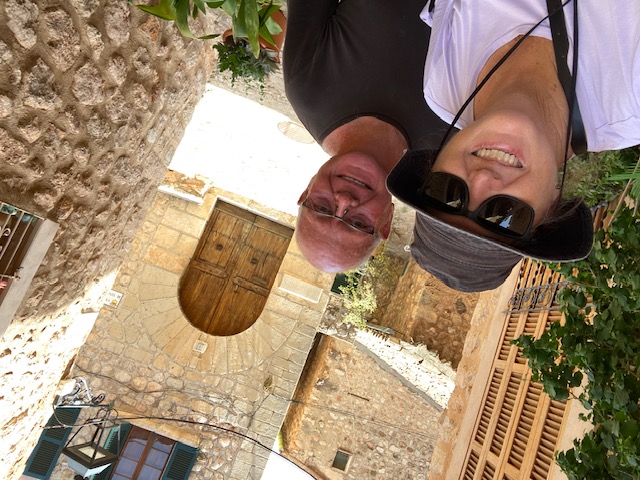
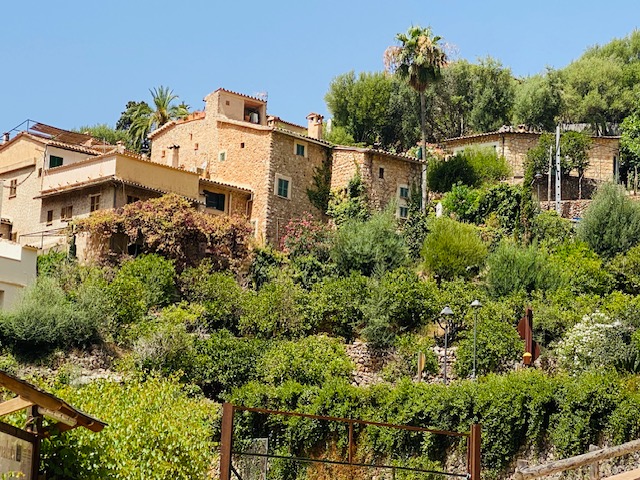
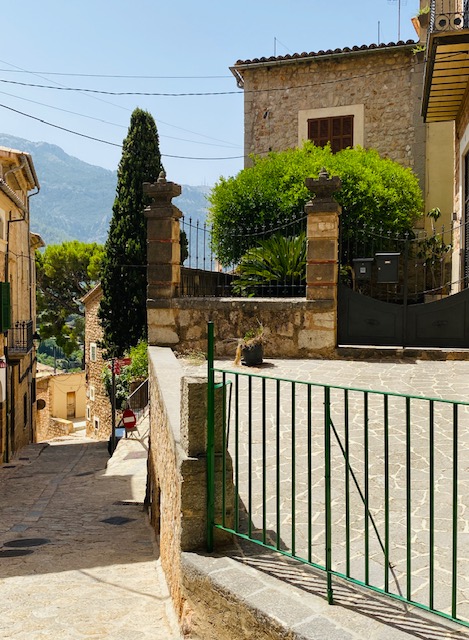
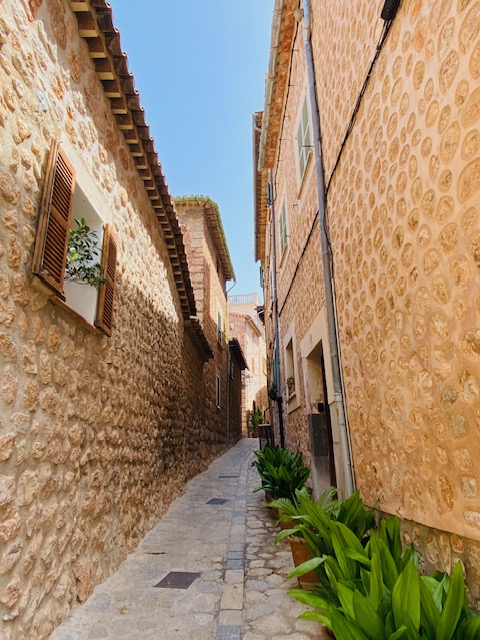
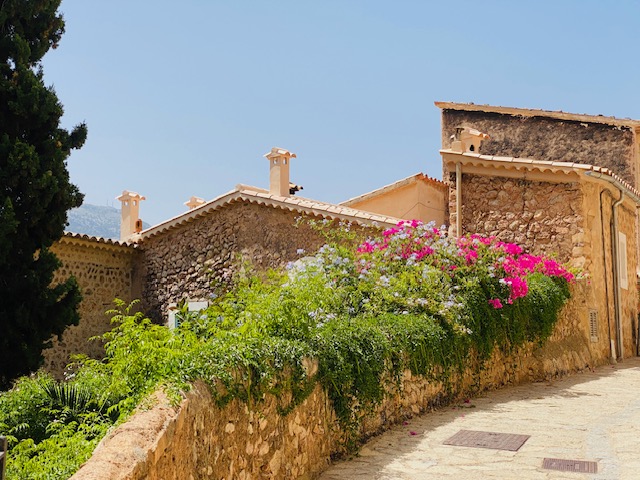
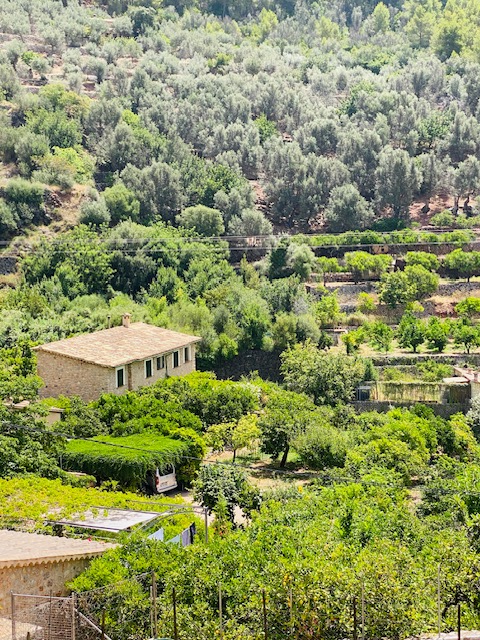
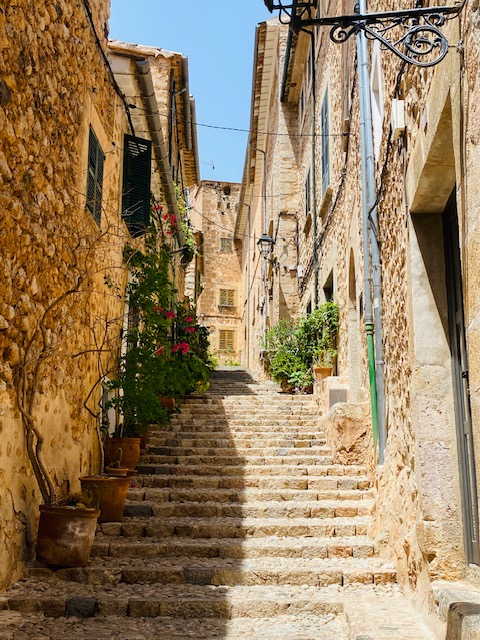
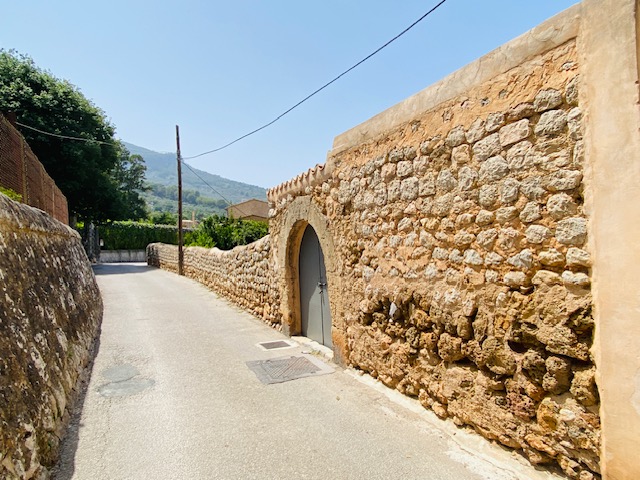
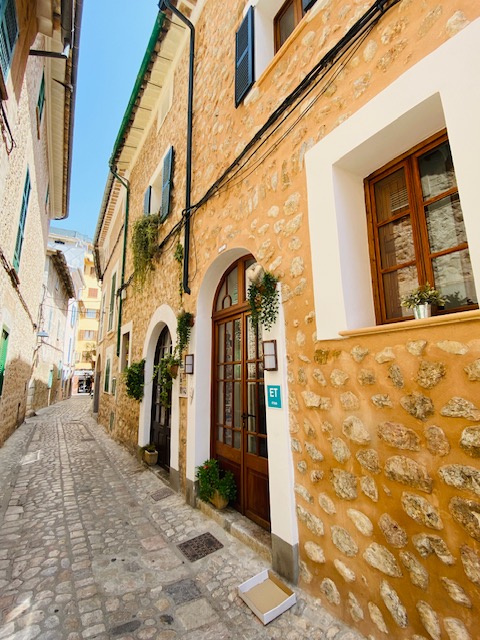
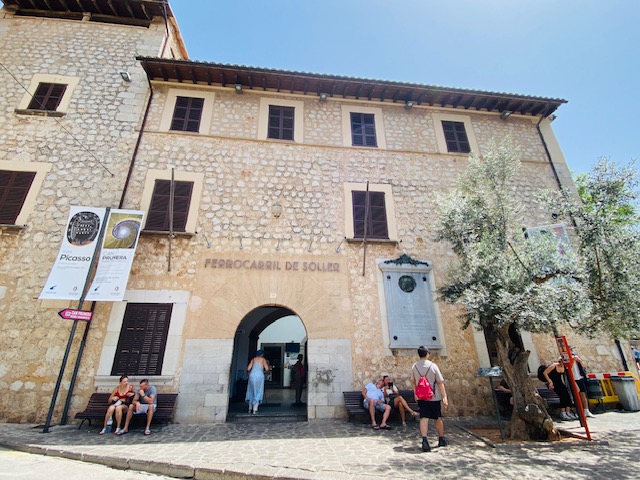
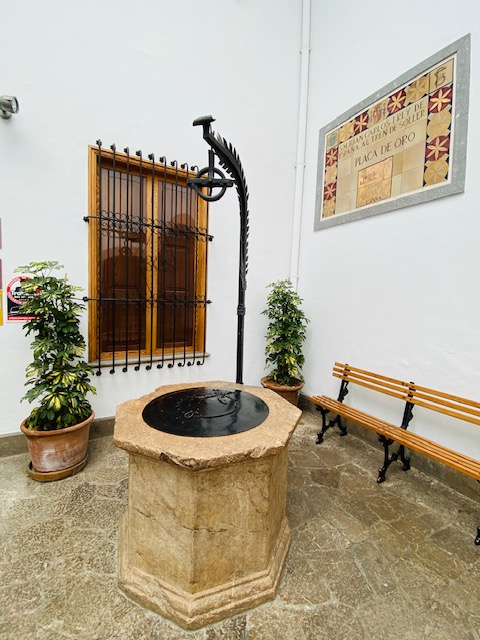
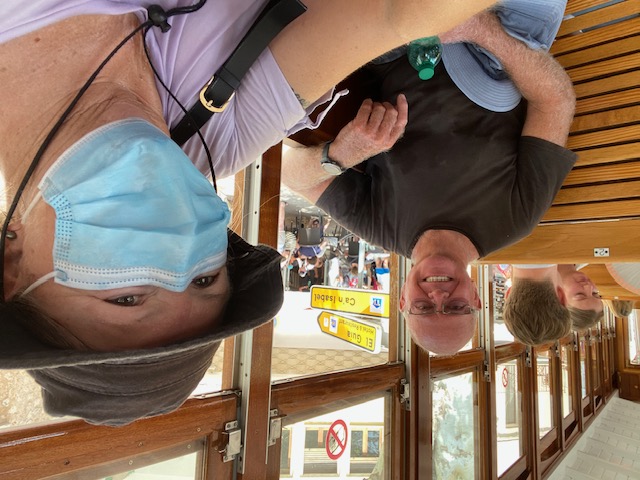
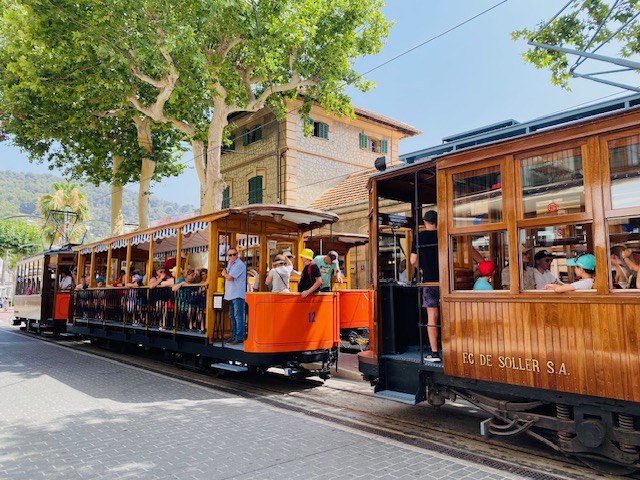
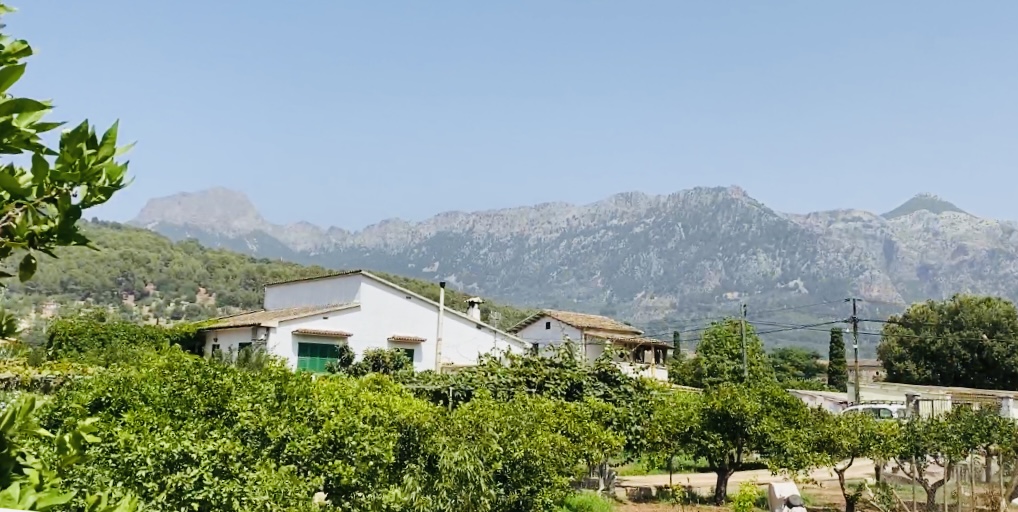
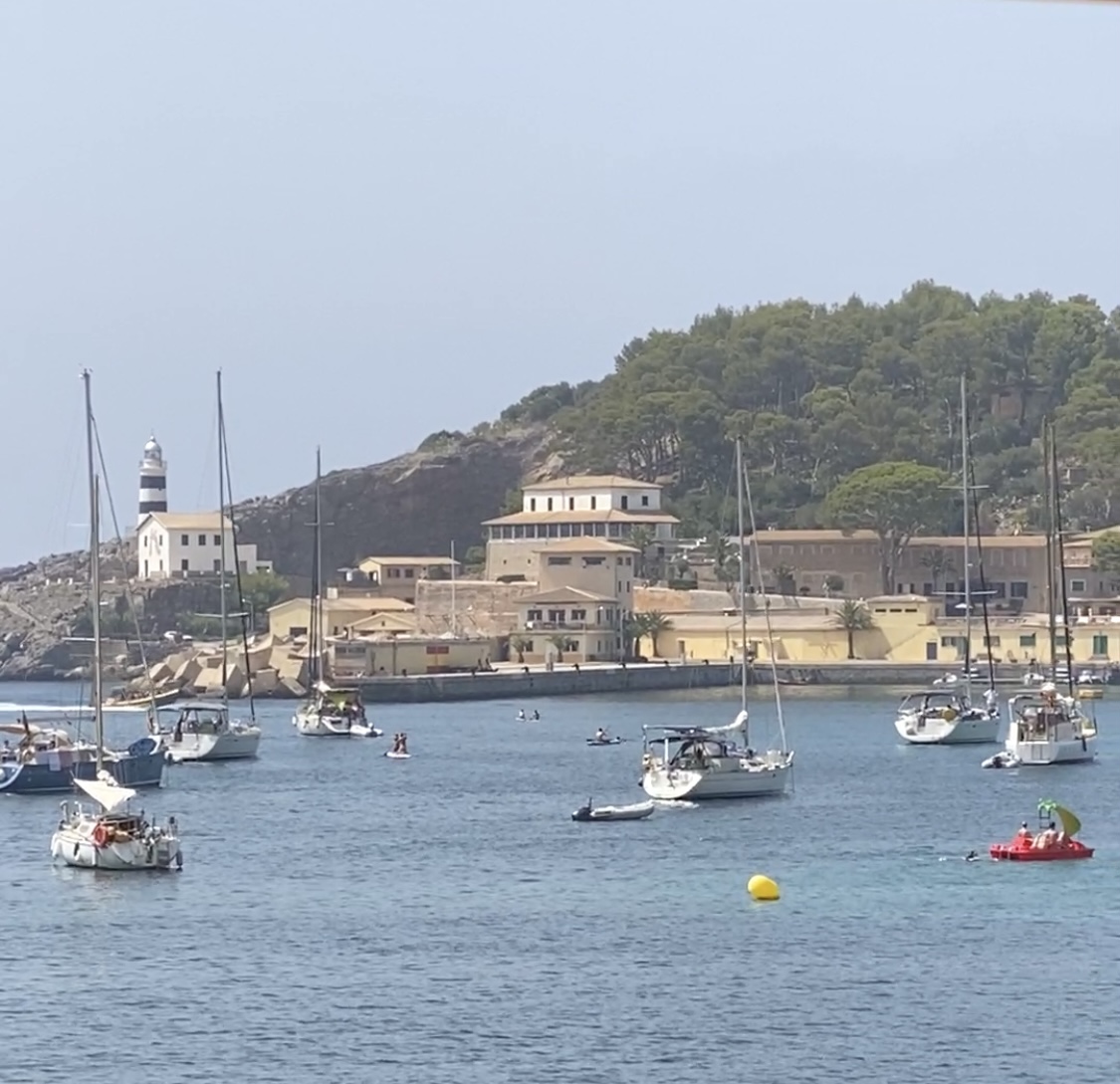
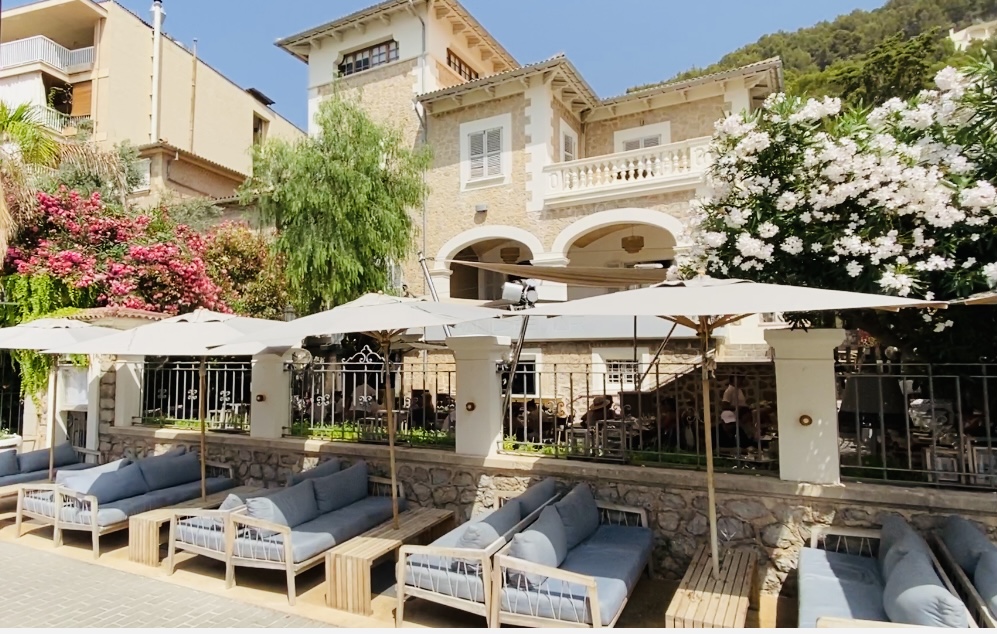
After catching up with Elaine’s sister, Dianne, on the latest developments concerning her dad, we both tried to nap, but gave up with all the bouncing around we did in the wakes of the speedboat revellers out again in full force. Instead we hopped in the dinghy and spent the rest of the afternoon and evening ashore.
First, coffee and cake was enjoyed at the Cultural restaurant, where we lingered in the coolness of their lounge and finalised our route from Mallorca to Ibiza and Formentera islands. Then a stroll along the waterfront and finding a shady spot on the beach passed some time until dinner, enjoyed at the Himalayan Curry House. The last time we enjoyed a curry was in Malaysia and this meal was definitely a delicious treat to rival that of the Kapitan restaurant in Penang.
By the time we returned to Paw Paw the wind had died down and the churned up sea state from all the revellers had settled, both ensuring we didn’t get drenched in the dinghy.
This morning Roy was up earlier to take advantage of the calmer conditions to clean Paw Paw’s bottom. Then, after breakfast, he took a bus to the local industrial park to purchase engine oil, while Elaine did the laundry. However, on his return, he was unfortunately unable to do the engine oil changes today, something which really only needs to be done in Gibraltar, but he wanted to make use of our downtime, only to remember we were out of oil filters; a very unusual circumstance on Paw Paw, but, since we were unable to source them in Turkey after he’d depleted our stock getting Paw Paw ready for the season, we figured we wouldn’t need to do another oil change until Gibraltar, but we’ve done a lot more motoring than we ever thought we’d be doing. In fact all we’ve done is motor. No harm, no foul, though, as we can source them here or in Gibraltar and he did the saildrives and dinghy oil changes in the interim. Afterwards he also did another diesel run in the dinghy and had a bunch of local kids out on a kayak excursion for entertainment, while Elaine had a nap.
The good news of the day, however, was that Elaine’s dad was discharged. We’ve no idea what caused these particular episodes and neither do the medical fraternity actually, putting it down to the usual diagnosis of “heart failure”, although each of the last three episodes have been entirely different; guess we’ll chalk it up to old age and be grateful that he’s still this side of the grass.
What we weren’t pleased to learn was that the Orca attacks have now spread to La Linea in the Bay of Algeciras / Bay of Gibraltar and into the Mediterranean Sea along the Spanish coast near La Alcaidesa and Sotogrande, right where we’re heading in the next few weeks, with four attacks in all happening yesterday in these two areas; just dandy! During this circumnavigation we’ve dealt with unpredictable weather and numerous storms that locals said they’d never encountered before, a late season cyclone, a rogue wave that dismantled our steering system in a matter of seconds, a pandemic, pirate alley en route to the Suez Canal, a serious medical diagnosis for Elaine that we didn’t see coming and which is bringing our sailing days to an end prematurely and now orcas! Really!
Setting that concern aside, our day ended with a gelato ashore and a walk along the waterfront to enjoy the cool breeze before retiring to bed.
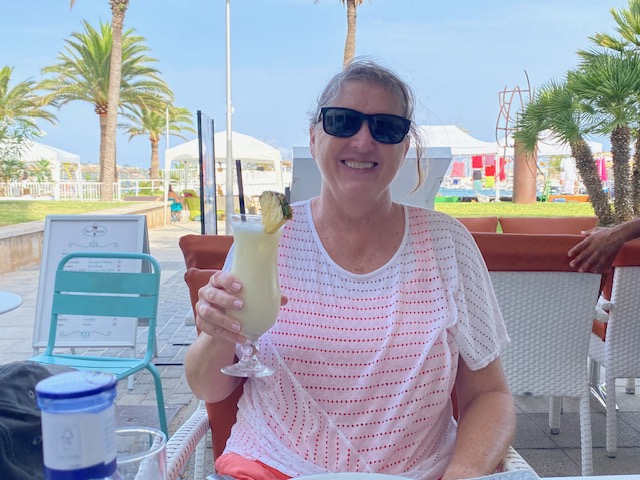
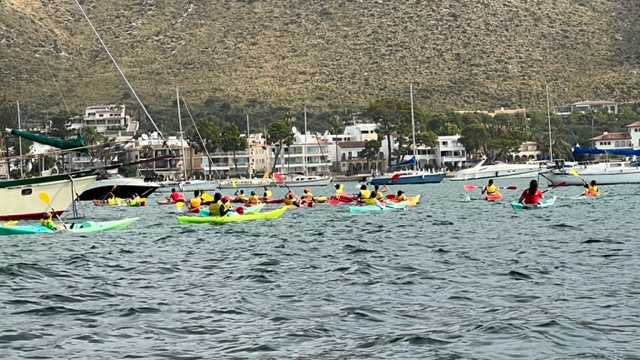
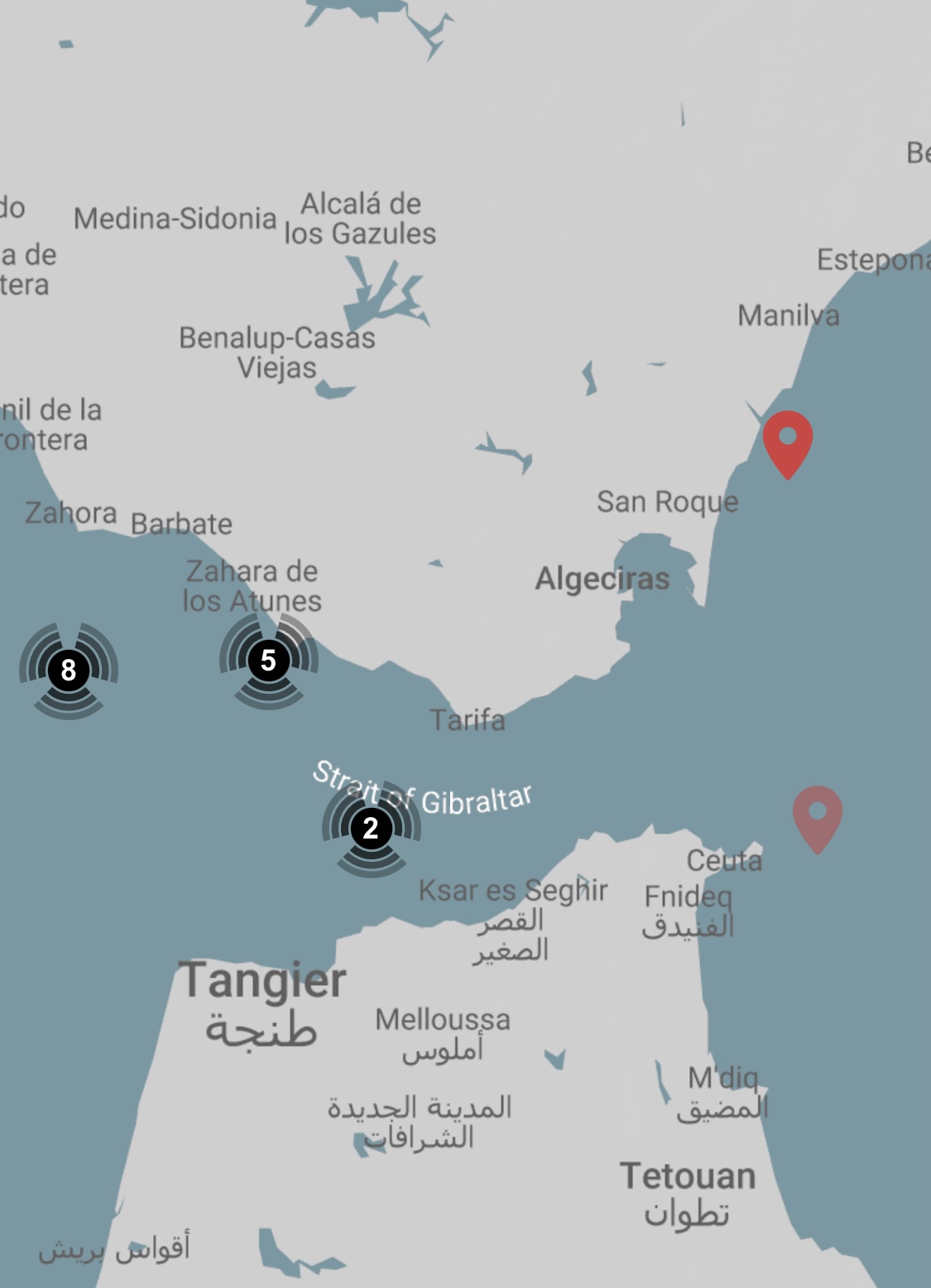
It was more beautiful close up, given that the area we’d seen yesterday was at the top of the cliff, with a series of steps taking us down to the waterfront and the little beach today.
After having a snoop around Cala Barques and Cala Clara, enjoying the beautiful seascapes with a kaleidoscope of clear blue water, lapping rocks, ancient ruins and the white sandy beach, we stopped at one of the restaurants, Niu, for a coffee. Fortunately the onshore cool breeze helped keep the temperatures at bay as well.
For lunch, we returned to street level and enjoyed a tasty meal at the Marina restaurant, although there wasn’t a marina anywhere to be seen. We were early enough, though, to get a table on the balcony to enjoy our meal in the cool breeze, following which it was time to catch our return bus.
Back onboard by mid afternoon, we whiled away the rest of the day doing pretty much nothing, except read and chat to Elaine’s sister, Dianne, after her dad had had another episode this afternoon while in the hospital. Things were definitely looking rather precarious on that front, but all we could do was hope and pray he makes a recovery, once the doctors figure out what’s causing all of this and that he gets to go home soon.
A light dinner, in sweltering heat, after the wind died completely, brought our day to a close.
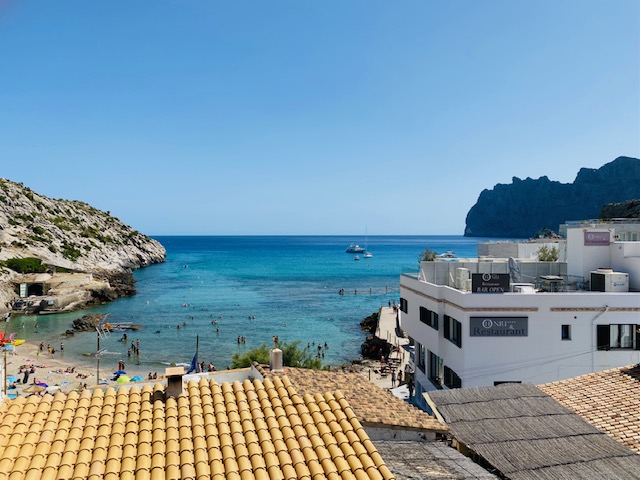
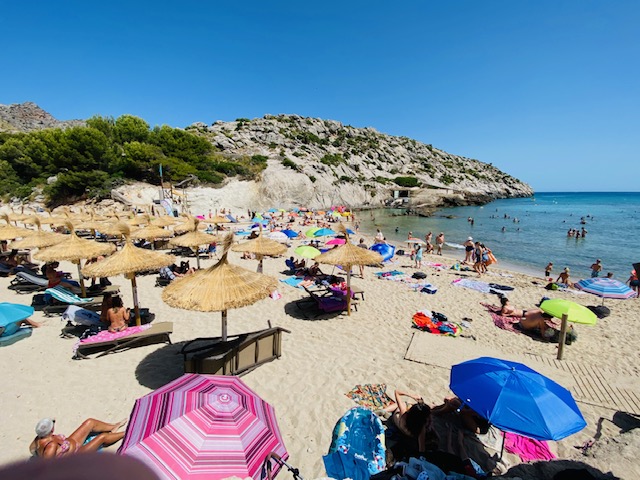
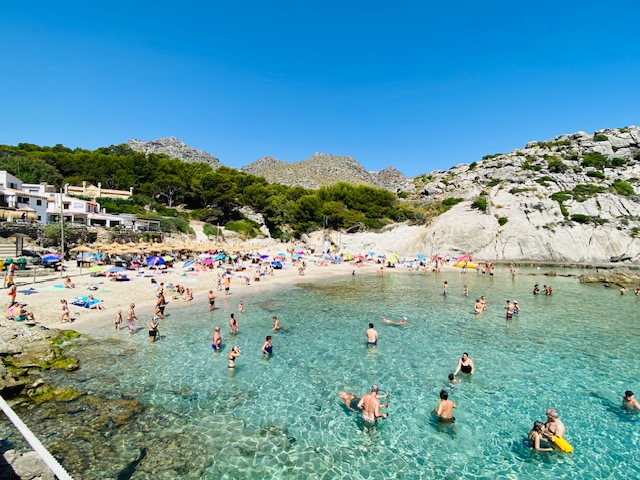
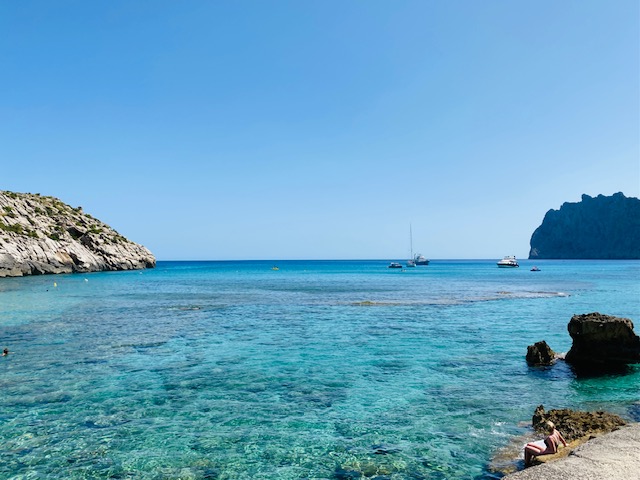
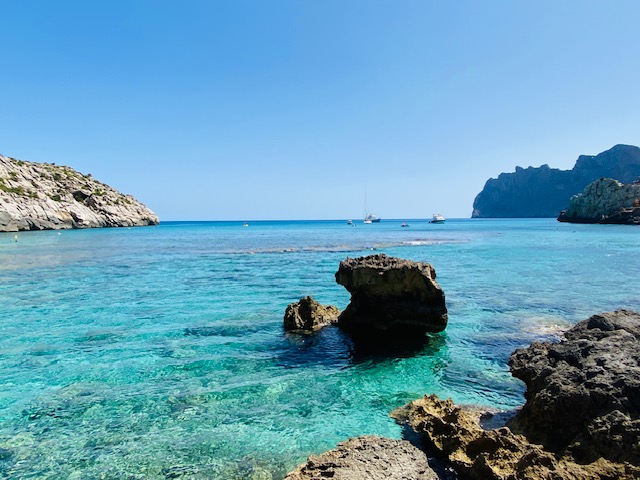
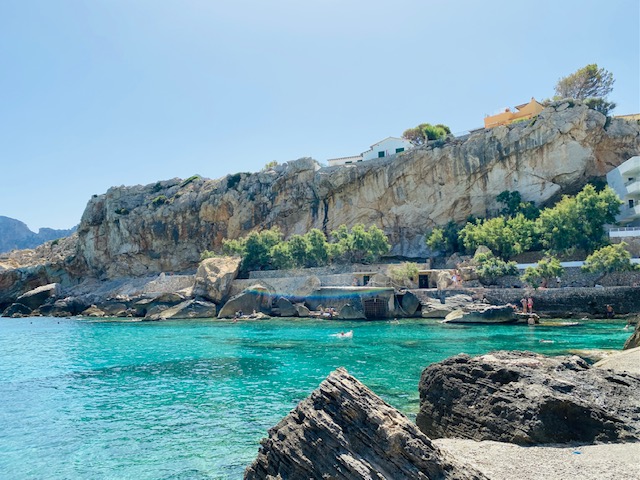
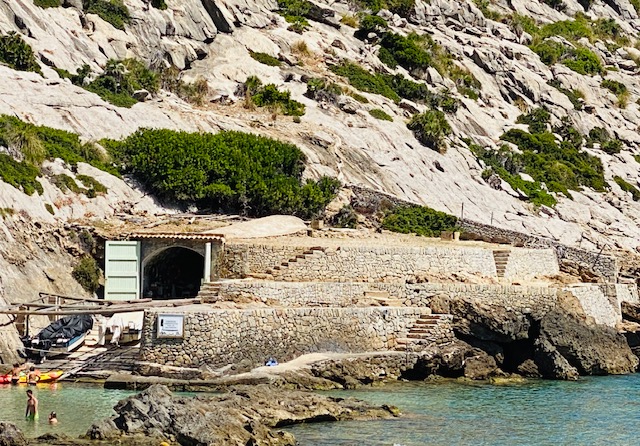
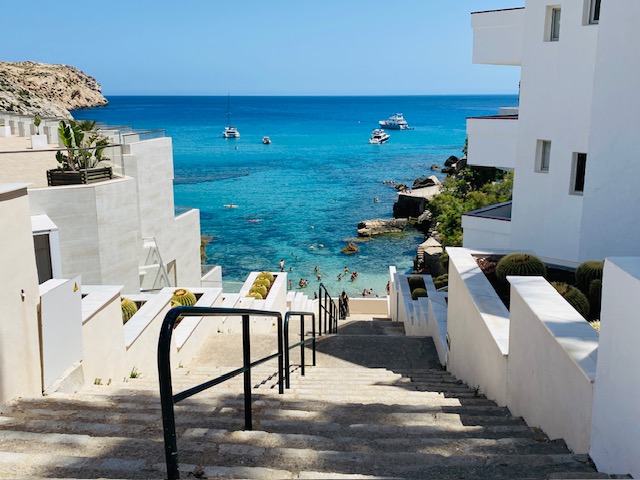
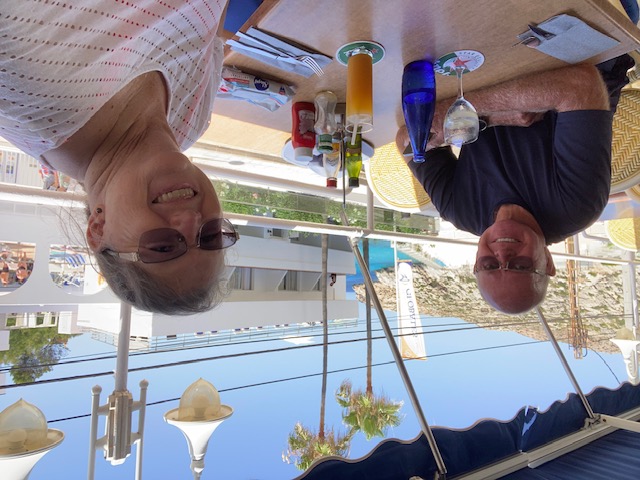
Afterwards we strolled to the very pleasant town square, with its huge trees providing much needed shade, and enjoyed a coffee in the very welcoming, comfortable and cool indoor seating area of the Cultural Restaurant; a much quieter atmosphere than the beachfront. Not wanting to return to Paw Paw and the heat, we lingered a little longer than normal.
Stopping to collect a freshly baked baguette, we eventually returned to Paw Paw for a late lunch and definitely welcomed the cool breeze that was blowing, given that Spain has been sweltering for days in temperatures of up to 45C / 113F, with overnight temperatures in many parts of the country not dropping below 25C / 77F. According to newsfeeds, parts of Mallorca reached 37C on Wednesday. However, we’re pleased to have left Italy just in time, where forecasters are warning that the next heatwave, dubbed “Charon”, after the ferryman who delivered souls into the underworld in Greek mythology, will push temperatures up towards 43C / 109F in Rome and a possible 47C / 116F on the island of Sardinia.
Today, to escape the heat on the island of Mallorca, we decided to head for the mountains, the Tramuntara Mountains to be specific, by way of a bus ride to the little town of Pollença, passing through Cala de Sant Vincenç, situated on the northern side of the Formentor peninsula. This northerly municipality in the Tramuntana Mountains stands out for its coastline and geography full of contrasts, from towering rugged mountains, valleys and plains to magnificent cliffs, all of which enticed poets, painters and musicians during the early decades of the 20th Century, including the painter, Hermen Anglada Camarasa, who lived in Pollença until his death.
After our arrival in Pollença, a short walk took us to “Plaça Major” (the main square) in the old quarters, where we found the Baroque-style parish church, “Parròquia de la Mare de Déu del Angels” (Our Lady of the Angels), and the beautiful re-purposed houses of Can Llobera, Ca n’Auli, Ca n’Olesa and Ca n’Aixartell, passing the “Museu de Pollença” (Museum of Pollença), “Torre Desbrull” (Tower of Desbrull), all stunning old buildings, and Sant Domingo Church and Monastery, built In the late 16th / early 17th Centuries by the Dominican Friars.
This small town dates back to the 12th Century when it was first settled by Moors from North Africa. However, from local archaeological discoveries, it is believed that the area was initially inhabited as far back as 2000 BC and by the Romans in 123 BC.
The Moors were driven out by the forces loyal to King James I of Aragon during his occupation of the Island in around 1230 AD, assisted by the loyal Aragon Knights, also known as the infamous Knights Templar. The loyalty of the Knights was rewarded when King James I gave them the town of Pollença. Many examples of their occupation can be seen around the town today, but their most significant contribution was the building of “Parròquia de la Mare de Déu del Angels”.
The Knights Templar left the Island in the 14th Century and, while most of the houses seen today in the town were built in the 17th and 18th Centuries. the church was rebuilt in the current baroque-style in the 18th Century, with around 15 very ornate, beautiful chapels within the building and magnificent frescoes on the walls and ceiling. It was, however, the alter and the stain glass window to the rear of the church that were simply stunning. Unfortunately Elaine was unable to get a decent photograph of the exterior of the church because the town was setting up for the “Festival de Pollença”, a classical music festival that takes place in the month of August each year, but she got a few of the interior and one at a distance of the church tower.
After a coffee at Numero Ocho Brasserie in the shade of the trees on the square, we wondered around the narrow, slate paved streets finding “Plaça de L’Almoina” and “Font del Gall” as we strolled, the latter a fountain bearing a sculpture of a cockerel, the town’s symbol.
Our final stop was “Jardins de Joan March”, where we sat under a tree and chatted to Elaine’s sister, Dianne, primarily to get an update on Elaine’s dad.
Our day ended with a cold beverage on the waterfront, but getting soaked in the dinghy on our return to Paw Paw after the winds shifted to the south, creating quite a fetch, followed by a short, but pleasant phone call to Elaine’s dad, who was delighted to hear from us.
